North Dakota, located in the northern region of the United States, is known for its stunning landscapes, vast prairies, and extreme winter weather conditions.
Despite the harsh and frigid winter season, North Dakota is home to many bird species that survive and thrive throughout this challenging time of the year.
From the charismatic and vibrant Northern Cardinal to the majestic and snow-loving Snowy Owl, winter in North Dakota offers a unique opportunity to witness an enchanting variety of birds that have adapted to the cold climate and bring a touch of colour and life to an often barren and snow-covered landscape.
In this article, we will explore the fascinating world of winter birds in North Dakota, their captivating behaviours, and the remarkable ways in which they navigate through some of Nature’s toughest conditions.
47 Winter Birds In North Dakota
In North Dakota, the winter landscape hosts a variety of bird species, some of which are year-round residents while others are winter visitors. Here is a list of 47 birds you might see in North Dakota during the winter months:
1. Downy Woodpecker
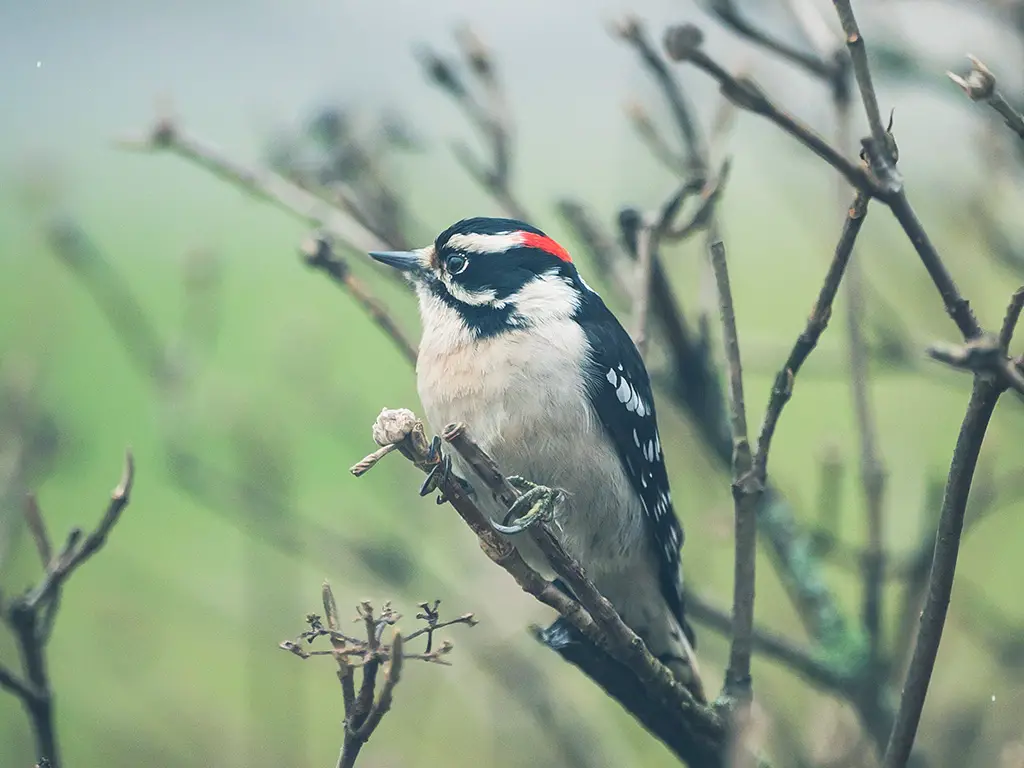
The downy woodpecker is a type of bird known as a woodpecker. It is the smallest species of woodpecker found in North America. Its size can range from 14 to 18 centimetres.
These woodpeckers can be found in various forested areas across the United States and Canada.
However, they are not commonly seen in desert regions in the southwest or in the northern tundra. Due to their small size, downy woodpeckers are well-adapted to living in forested environments.
They can navigate through the trees and search for food more easily than larger woodpecker species. One interesting feature of the downy woodpecker is its ability to drum on trees.
This drumming serves multiple purposes, including communication with other woodpeckers and marking its territory. The diet of the downy woodpecker primarily consists of insects and larvae found within the trees.
They use their strong beaks to peck at the bark and wood, uncovering their prey. These woodpeckers are known for their distinct black and white plumage. They have a white belly and back, with black wings and a black head. This coloration helps them blend in with the tree.
| Kingdom | Animalia |
| Phylum | Chordata |
| Clade | Dinosauria |
| Class | Aves |
| Order | Piciformes |
| Family | Picidae |
| Genus | Dryobates |
| Species | D. pubescens |
2. Black-Capped Chickadee
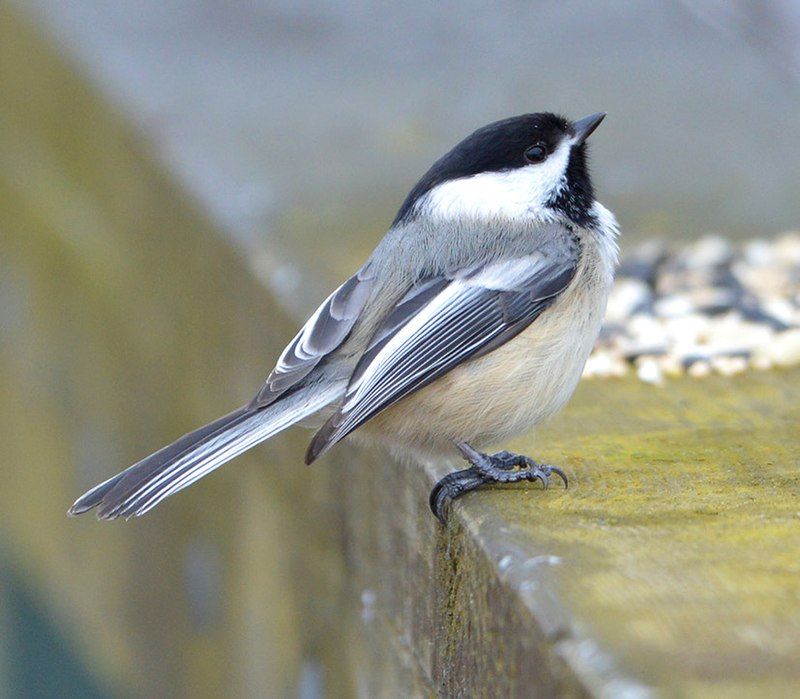
The black-capped chickadee is a small songbird that can be found in North America. It is known for its distinctive black cap and white cheeks.
This bird is not migratory, meaning it does not travel long distances during different seasons. The black-capped chickadee prefers to live in deciduous and mixed forests.
These types of forests provide the bird with the necessary habitat, such as trees and shrubs, where it builds its nests and finds food.
As a passerine bird, it belongs to the tit family, which is scientifically called Paridae. Interestingly, the black-capped chickadee holds special significance in certain regions.
It is the state bird of Massachusetts and Maine in the United States, symbolizing its importance to the local environment and culture.
Additionally, in Canada, specifically in the province of New Brunswick, it is recognized as the provincial bird. Overall, the black-capped chickadee is a small, nonmigratory songbird that can be found in North America.
It thrives in deciduous and mixed forests and belongs to the tit family. Its significance is acknowledged through its designation as the state bird in Massachusetts and Maine, as well as the provincial bird of New Brunswick.
| Kingdom | Animalia |
| Phylum | Chordata |
| Clade | Dinosauria |
| Class | Aves |
| Order | Passeriformes |
| Family | Paridae |
| Genus | Poecile |
| Species | P. atricapillus |
3. American Goldfinch

The American goldfinch is a type of bird that is found in North America.
It belongs to the finch family, which is a group of small birds known for their colourful feathers and pleasant songs. This bird is migratory, meaning it travels from one place to another depending on the time of year.
During the breeding season, which is when they mate and lay eggs, the American goldfinch can be found in areas ranging from mid-Alberta in Canada to North Carolina in the United States.
When the weather gets colder in the winter, the American goldfinch migrates to a different region.
They move from just south of the Canada–United States border and travel all the way down to Mexico.
This helps them find better conditions for survival as the temperature and food availability change with the seasons. The reason for their migration is mainly related to the availability of food.
During the breeding season, the American goldfinch feeds on insects and seeds from plants like sunflowers and thistles.
These food sources are abundant in the areas where they breed, providing them with the necessary nutrients for reproduction and raising their young.
However, these insects and plants may not be readily available in their breeding grounds during the winter.
| Kingdom | Animalia |
| Phylum | Chordata |
| Clade | Dinosauria |
| Class | Aves |
| Order | Passeriformes |
| Family | Fringillidae |
| Genus | Spinus |
| Species | S. tristis |
4. American Robin
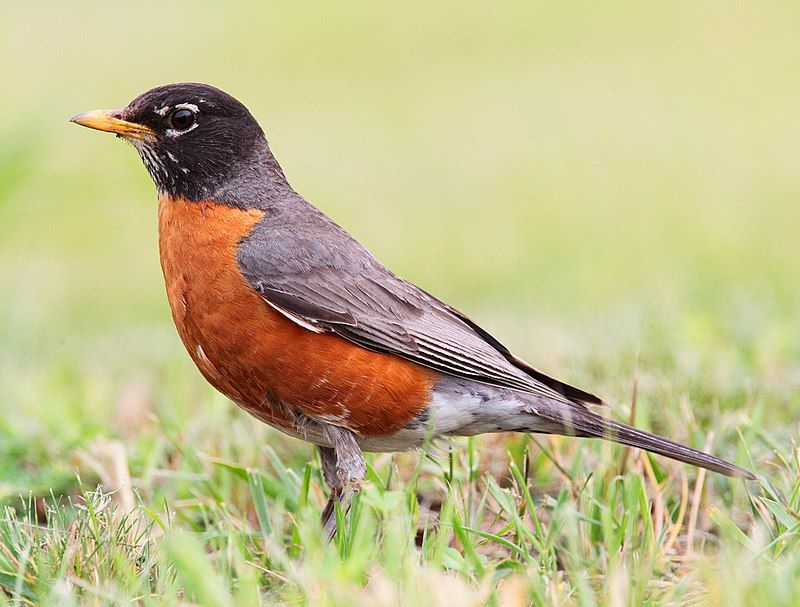
The American robin is a type of bird that migrates. It belongs to the true thrush genus and the Turdidae family, which is a larger family of thrushes. It gets its name from the European robin because of its reddish-orange breast.
However, it is important to note that the American and European robin are not closely related. The European robin is a different species and belongs to the Old World flycatcher family.
Despite their similar names and physical characteristics, these two birds are not closely related regarding their genetic makeup.
They may share some similarities in appearance, such as the reddish-orange breast, but their evolutionary paths have taken them in different directions. The American robin is primarily found in North America, while the European robin is native to Europe and parts of Asia.
Both species have adapted to their respective environments and habitats over time.
The American robin is known for its ability to migrate long distances, often travelling south during winter and returning north for the breeding season. Regarding physical characteristics, the American robin is larger than the European robin.
It has a greyish-brown back and a distinct reddish-orange breast, which is a defining feature of the species.
| Kingdom | Animalia |
| Phylum | Chordata |
| Clade | Dinosauria |
| Class | Aves |
| Order | Passeriformes |
| Family | Turdidae |
| Genus | Turdus |
| Species | T. migratorius |
5. Blue Jay
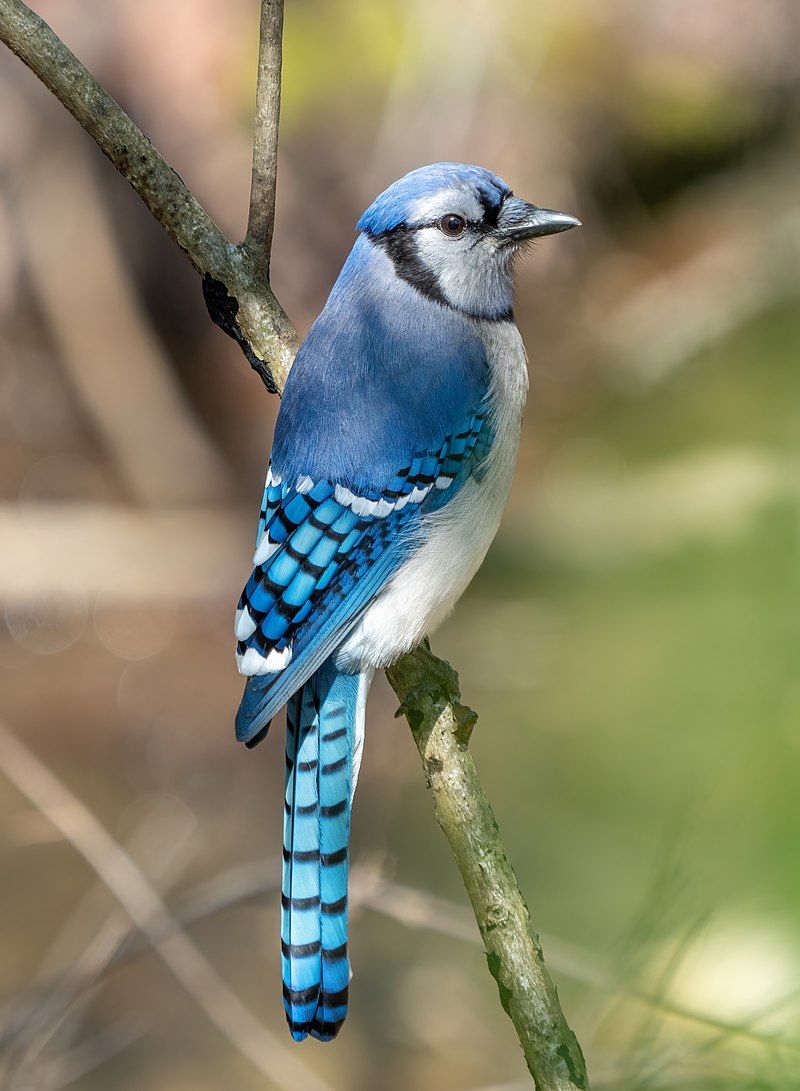
The blue jay is a type of bird that belongs to the family Corvidae. It can be found in eastern North America. This bird is commonly found in many eastern and central United States parts.
However, it is important to note that some blue jays in the eastern regions may migrate to other areas. In addition to the United States, blue jays also reside in Newfoundland, Canada. They are considered residents in this area.
Breeding populations of blue jays can be observed across southern Canada. This means that these birds reproduce and raise their young in this region. The blue jay is a passerine bird, meaning it has specialized feet that allow it to perch on tree branches.
It is native to eastern North America and can be found in various parts of the United States, Newfoundland, and southern Canada.
| Kingdom | Animalia |
| Phylum | Chordata |
| Clade | Dinosauria |
| Class | Aves |
| Order | Passeriformes |
| Family | Corvidae |
| Genus | Cyanocitta |
| Species | C. cristata |
6. White-Breasted Nuthatch
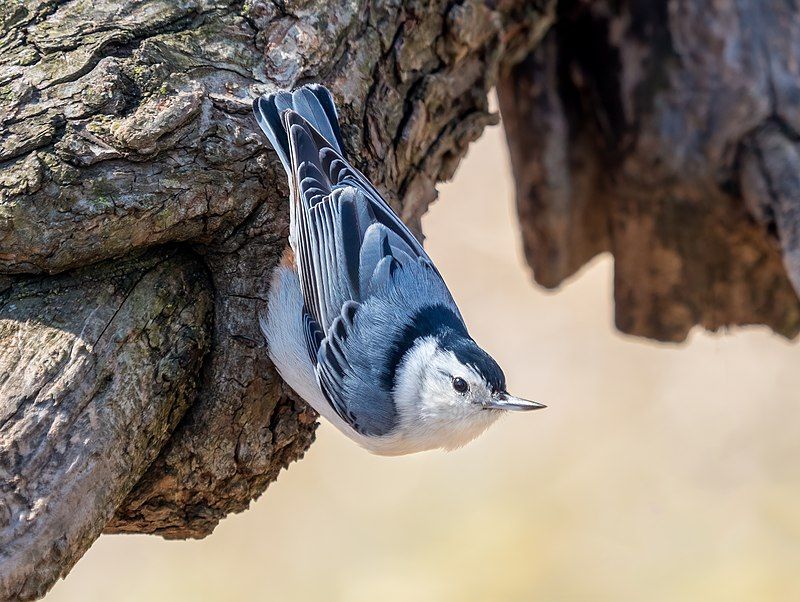
The white-breasted nuthatch is a type of bird that belongs to the nuthatch family called Sittidae.
This family includes various species of nuthatches, but we will focus on the white-breasted nuthatch in this discussion. The white-breasted nuthatch is considered to be a medium-sized bird, measuring around 15.5 cm in length.
This measurement gives us an idea of its size compared to other birds. While it may not be the largest bird out there, it is also not the smallest. One interesting feature of the white-breasted nuthatch is its white breast, which gives it its name.
This white colouration on its chest stands out and helps to identify it from other species of nuthatches.
It is worth noting that not all nuthatches have this specific feature, making it unique to the white-breasted nuthatch. As a nuthatch family member, the white-breasted nuthatch shares certain characteristics with other nuthatch species.
For example, nuthatches are known for their ability to climb up and down trees headfirst. This behaviour is quite fascinating to observe, as most birds can only move in an upward direction.
| Kingdom | Animalia |
| Phylum | Chordata |
| Clade | Dinosauria |
| Class | Aves |
| Order | Passeriformes |
| Family | Sittidae |
| Genus | Sitta |
| Species | S. carolinensis |
7. Dark-Eyed Junco
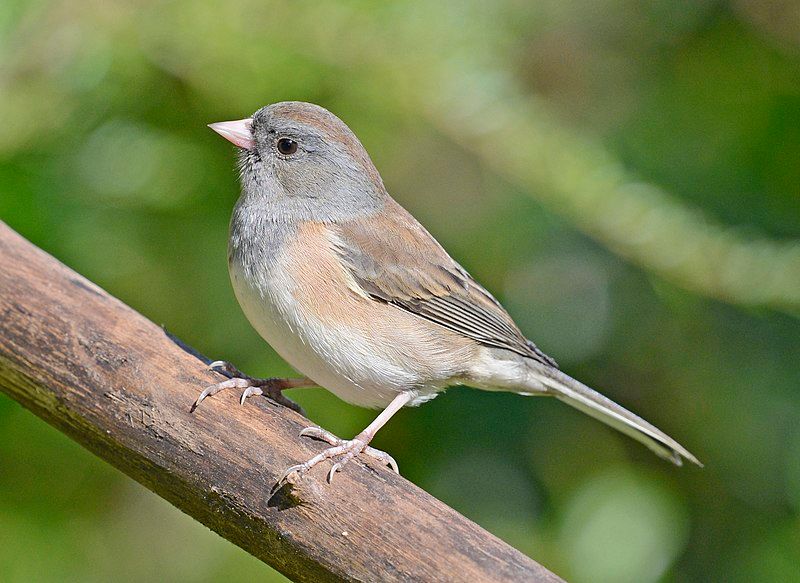
The dark-eyed junco is a type of bird called a junco. Juncos are small, greyish sparrows that live in the New World. The dark-eyed junco is found in many parts of temperate North America, and during the summer, it even goes as far as the Arctic.
The dark-eyed junco is a species that has a lot of variation. This means that different individuals of this bird can look quite different from one another. It is similar to another species of sparrow called the fox sparrow in terms of its variability.
Despite being studied by scientists, the systematics of the dark-eyed junco are still not fully understood. Systematics refers to studying the relationships between different species and their classification.
So, even though researchers have been trying to figure out how the dark-eyed junco fits into the larger picture of bird species, there are still some unanswered questions.
| Kingdom | Animalia |
| Phylum | Chordata |
| Clade | Dinosauria |
| Class | Aves |
| Order | Passeriformes |
| Family | Passerellidae |
| Genus | Junco |
| Species | J. hyemalis |
8. Common Redpoll
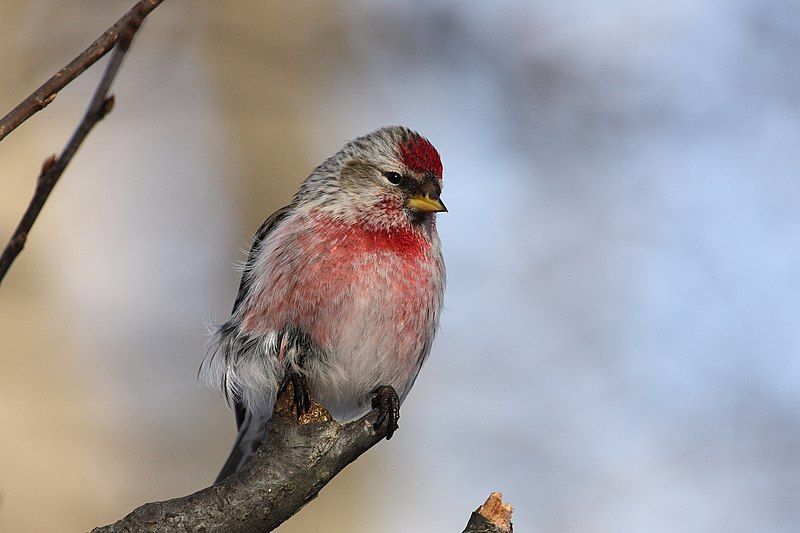
The common redpoll, also known as the mealy redpoll, is a type of bird. It belongs to the finch family, which includes other small birds with cone-shaped beaks.
The common redoll is found in various regions. Unlike the Arctic redpoll, the common redpoll breeds in areas that are slightly closer to the south. It prefers habitats that have thickets or shrubs.
These habitats provide the necessary resources and shelter for the bird to survive and reproduce. Thickets are dense areas filled with small trees or bushes. They often offer protection from predators and harsh weather conditions.
Shrubs, on the other hand, are woody plants that are smaller than trees but larger than herbs.
Both thickets and shrubs provide the common redpoll with suitable nesting sites and a source of food. The common redpoll’s choice of breeding habitat may be influenced by the availability of resources such as seeds, fruits, and insects.
Thickets and shrubs can offer the bird a diverse range of food options, helping it meet its nutritional needs during the breeding season. It is important to note that the common redpoll and Arctic redpoll are two separate species.
While they may share some similarities, such as their finch family classification.
| Kingdom | Animalia |
| Phylum | Chordata |
| Clade | Dinosauria |
| Class | Aves |
| Order | Passeriformes |
| Family | Fringillidae |
| Genus | Acanthis |
| Species | A. flammea |
9. Black-Billed Magpie
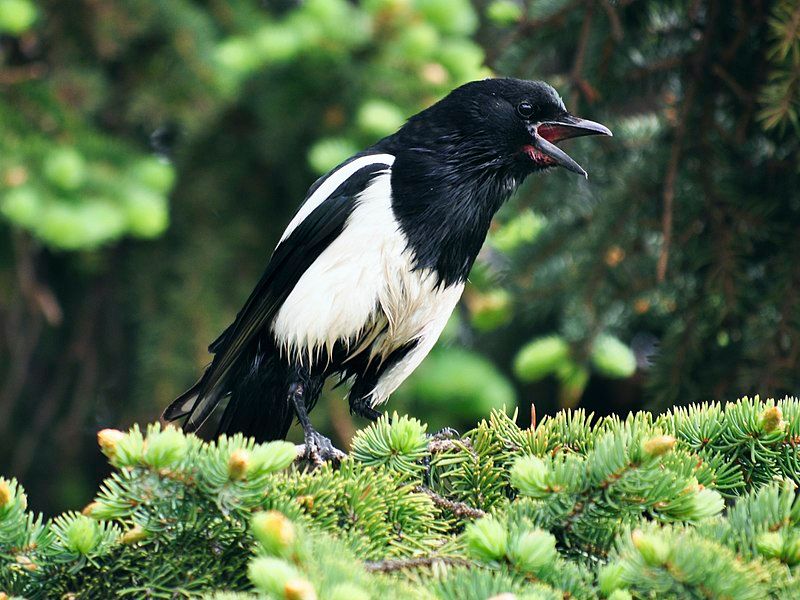
The black-billed magpie is a type of bird that belongs to the corvid family. It can be found in the western part of North America. Another name for this bird is the American magpie. In terms of appearance, the black-billed magpie is mostly black and white.
Its body is mainly black, but it also has areas of white feathers. These black and white colours create a striking contrast. The wings and tail of the black-billed magpie have black feathers as well.
However, looking closely, you may notice that these black areas have hints of iridescent colours like blue or blue-green.
When the light hits its feathers, these colours give the magpie a beautiful shimmering effect. The black-billed magpie is a visually appealing bird due to its contrasting black and white colours.
The iridescent hints of blue or blue-green on its wings and tail add an extra touch of beauty to this already remarkable creature.
| Kingdom | Animalia |
| Phylum | Chordata |
| Clade | Dinosauria |
| Class | Aves |
| Order | Passeriformes |
| Family | Corvidae |
| Genus | Pica |
| Species | P. hudsonia |
10. House Finch
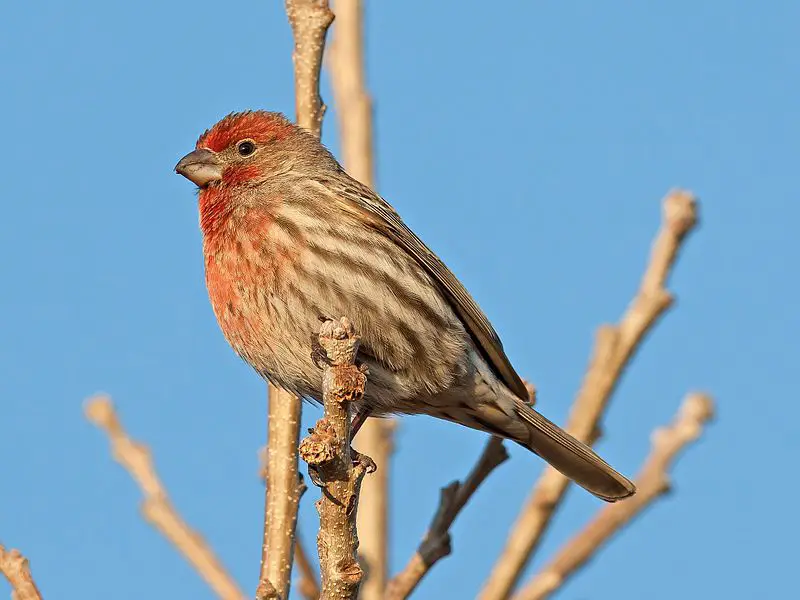
The house finch is a type of bird that belongs to the finch family called Fringillidae. This bird is originally from western North America.
However, it has also been introduced to other parts of the continent, such as the eastern half and Hawaii. The house finch is not the only bird in its genus.
It is grouped together with two other American rosefinches, and all three are placed in the genus Haemorhous. The house finch is known for its beautiful red colouration, especially in males. The males have a reddish hue on their heads, chests, and backs.
Females, on the other hand, have more muted colours with brownish feathers. These birds are relatively small in size, measuring about 12 to 16 centimetres in length. They have short wings and a slightly notched tail.
Their beaks are conical in shape and designed for cracking open seeds, their primary food source. House finches are highly adaptable and can be found in various habitats, including urban areas, forests, and grasslands.
They are known for their melodious songs, which they use to communicate and attract mates. Breeding season for these.
| Kingdom | Animalia |
| Phylum | Chordata |
| Clade | Dinosauria |
| Class | Aves |
| Order | Passeriformes |
| Family | Fringillidae |
| Genus | Haemorhous |
| Species | H. mexicanus |
11. Northern Flicker
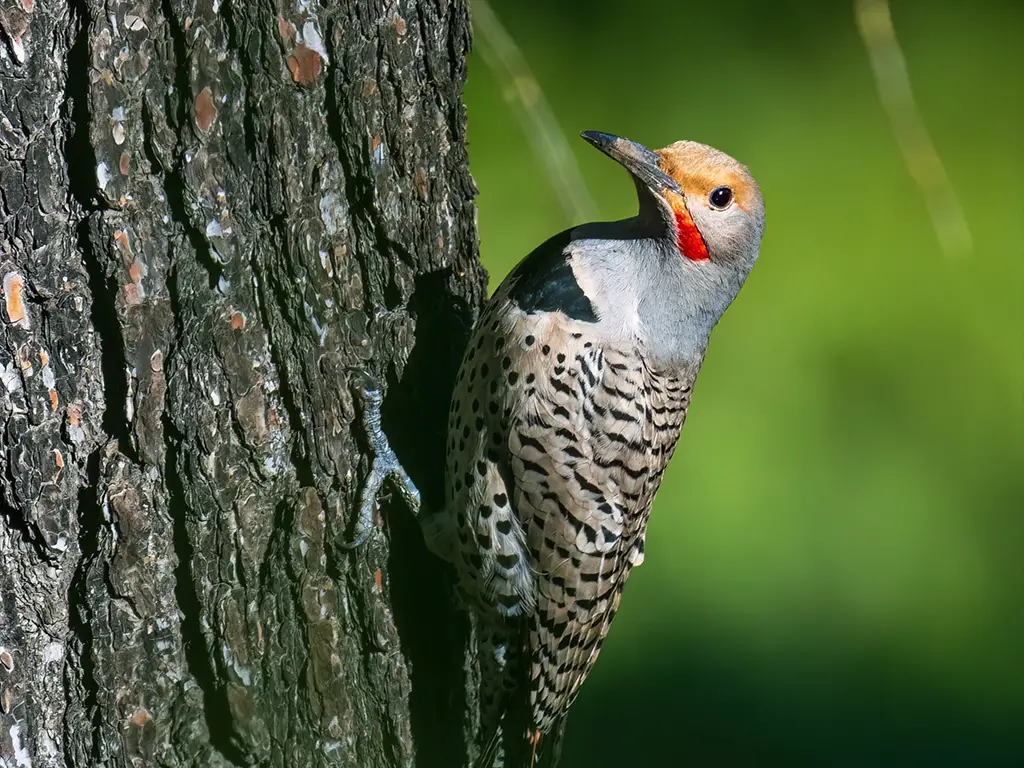
The northern flicker is a type of bird that belongs to the woodpecker family. It is not a very large bird but also not too small. The northern flicker can be found in many parts of North America.
It is also native to some areas in Central America, such as Cuba and the Cayman Islands. One interesting thing about the northern flicker is that it is one of the few woodpecker species that migrate.
Migration means that these birds travel from one place to another during different seasons. They do this to find food and suitable habitats.
The northern flicker migrates to different regions depending on the time of year. During the breeding season, which is usually in the spring or summer, the northern flicker can be found in many parts of North America.
They build their nests in trees and use their strong beaks to create holes in the wood. These holes are called cavities and serve as their homes. Northern flickers are known for their distinctive markings.
They have a brown body with black spots, and their wings have a white patch easily visible when flying. Another unique feature is the red or yellow colouration on the underside of their wings and tail.
| Kingdom | Animalia |
| Phylum | Chordata |
| Clade | Dinosauria |
| Class | Aves |
| Order | Piciformes |
| Family | Picidae |
| Genus | Colaptes |
| Species | C. auratus |
12. Common Starling
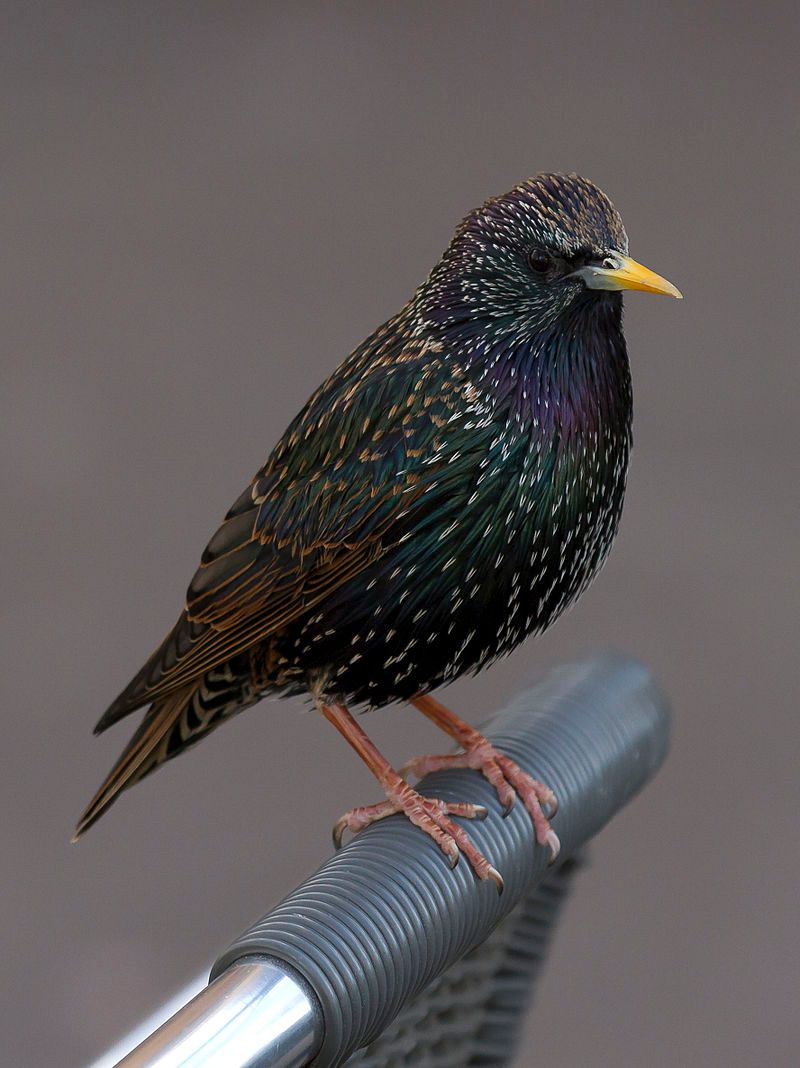
The common starling is a type of bird that can be found in various regions. Depending on the location, it is referred to by different names.
It is known as the European starling in North America, while it is called the starling in Great Britain and Ireland.
This bird belongs to the starling family, scientifically known as Sturnidae. The common starling is classified as a passerine bird with a medium-sized build.
Passerine birds are characterized by having feet adapted for perching, and they make up the largest order of birds.
The starling family, to which the common starling belongs, is known for its diverse species worldwide. The common starling is known for its unique features and behaviours.
It has a sleek and shiny black plumage with speckled spots, which gives it a distinct appearance.
The bird’s feathers can also appear iridescent in certain lighting conditions, showcasing shades of green and purple. One of the remarkable aspects of the common starling is its ability to mimic sounds and voices.
It has a wide range of vocalizations and can imitate various sounds it hears in its environment, including other bird calls, human speech, and even mechanical noises.
| Kingdom | Animalia |
| Phylum | Chordata |
| Clade | Dinosauria |
| Class | Aves |
| Order | Passeriformes |
| Family | Sturnidae |
| Genus | Sturnus |
| Species | S. vulgaris |
13. American Crow
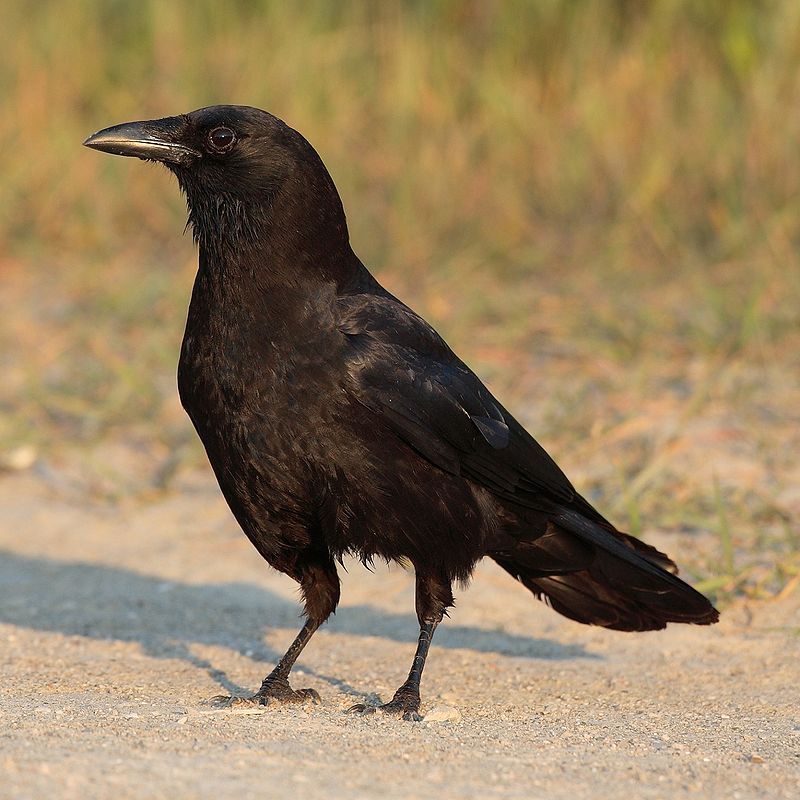
The American crow is a type of bird that belongs to the Corvidae family. This family includes other birds like ravens and jays. The American crow is quite big and is known as a passerine bird, meaning it has feet adapted for perching on branches.
You can find American crows in many parts of North America. They are a very common bird, so you might have seen them in your neighbourhood. They have adapted well to different environments and can be found in urban areas, forests, and even open fields.
Interestingly, American crows are similar to two other types of crows found in different parts of the world. These are the carrion crow and the hooded crow found in Europe and Asia.
Despite being from different continents, these three crows occupy the same ecological niche. An ecological niche refers to the role a species plays in its environment. In this case, the American crow, carrion crow, and hooded crow all have similar behaviours and habits.
They are opportunistic feeders, meaning they eat a wide range of things like insects, fruits, small animals, and even garbage. They also play important roles in controlling populations of certain pests and scavenging.
| Kingdom | Animalia |
| Phylum | Chordata |
| Clade | Dinosauria |
| Class | Aves |
| Order | Passeriformes |
| Family | Corvidae |
| Genus | Corvus |
| Species | C. brachyrhynchos |
14. Ring-Necked Pheasant
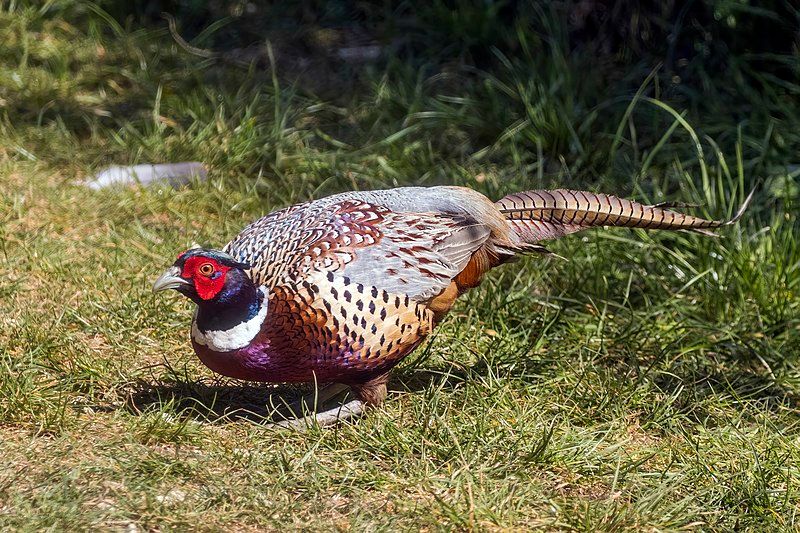
The common pheasant is a type of bird that belongs to the pheasant family. Its scientific name is Phasianus colchicus. The genus name, Phasianus, is derived from the Latin word “phasianus,” which means “pheasant.”The species name, colchicus, is also derived from Latin.
It means “of Colchis.” Colchis was a country located near the Black Sea. Pheasants were first discovered in this region and became known to Europeans. Pheasants are known for their vibrant and colourful plumage, which makes them a popular sight in many regions.
They have long, slender bodies and strong wings, which enable them to fly swiftly and gracefully. The common pheasant is a relatively large bird, with males typically being larger than females.
The males display striking colours, such as iridescent feathers and bright red or orange facial wattles.
These features are used to attract mates during the breeding season. On the other hand, female pheasants have more modest colours to blend in with their surroundings and protect themselves from predators.
Their plumage is often a combination of brown, grey, and black.
| Kingdom | Animalia |
| Phylum | Chordata |
| Clade | Dinosauria |
| Class | Aves |
| Order | Galliformes |
| Family | Phasianidae |
| Genus | Phasianus |
| Species | P. colchicus |
15. Red-Breasted Nuthatch
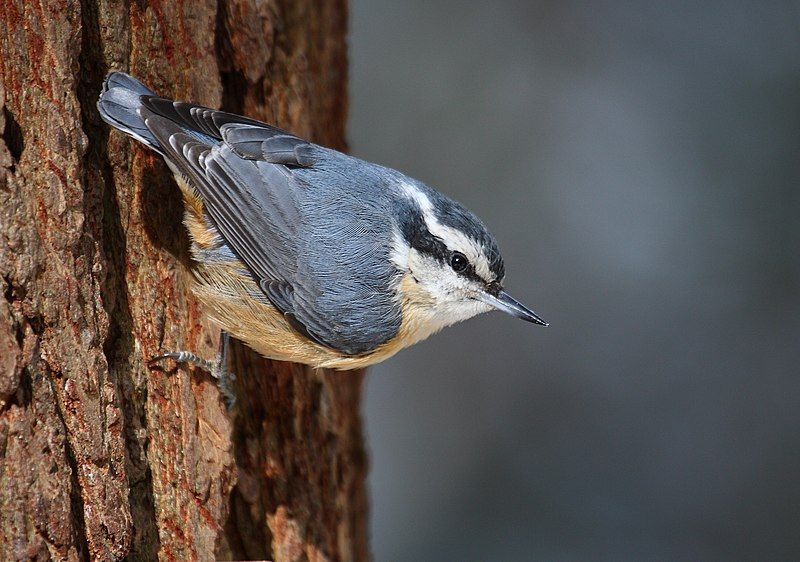
The red-breasted nuthatch is a small bird that is known for its beautiful appearance and unique characteristics. It has blue-grey feathers on its upper body and cinnamon-coloured feathers on its underparts.
This combination of colours creates a striking contrast. Looking closely at the red-breasted nuthatch, you will notice a white throat and face. These white areas provide a stark contrast against the rest of its body.
Additionally, a distinct black stripe runs through its eyes, giving it a charming and distinctive look. Another notable feature of the red-breasted nuthatch is its straight grey bill.
This bill is perfectly shaped for its feeding habits, allowing it to crack open seeds and nuts easily. The bird’s bill is functional and adds to its overall appearance. One of the most striking features of the red-breasted nuthatch is its black crown.
This black area on top of its head gives the bird a regal and elegant look. When combined with its blue-grey and cinnamon colours, the black crown adds a touch of sophistication to its appearance. Apart from its visual characteristics, the red-breasted nuthatch has a unique call.
Described as a tin trumpet, its call is high-pitched.
| Kingdom | Animalia |
| Phylum | Chordata |
| Clade | Dinosauria |
| Class | Aves |
| Order | Passeriformes |
| Family | Sittidae |
| Genus | Sitta |
| Species | S. canadensis |
16. Great Horned Owl
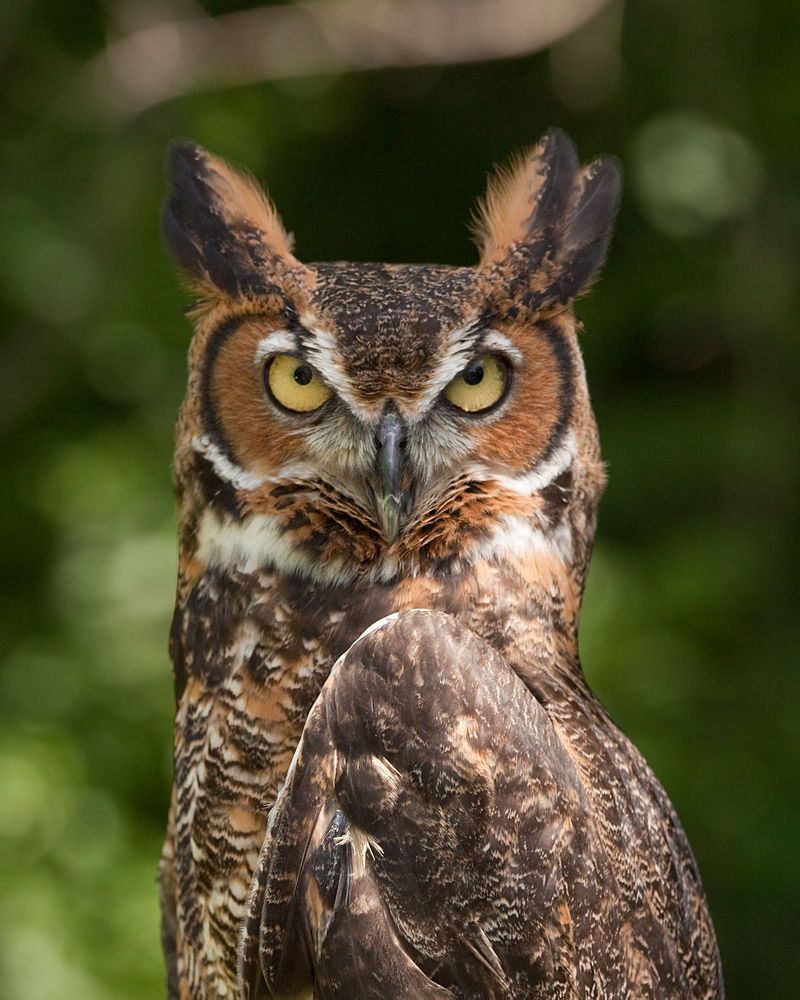
The great horned owl is a species of owl found in the Americas. It is also known by other names, such as the tiger owl and the hoot owl.
This owl is known for its adaptability and can be found in various habitats across its wide range. Being a large owl, the great horned owl has a distinct appearance. It has prominent ear tufts on its head, which give it a horned appearance.
This characteristic distinguishes it from other owl species. One of the remarkable traits of the great horned owl is its adaptability. It can be found in many habitats, including forests, deserts, mountains, and even urban areas.
This versatility allows the owl to thrive in diverse environments, making it the most widely distributed true owl in the Americas. The great horned owl is a skilled hunter, preying on various animals. Its diet includes small mammals like rabbits, mice, and rats.
Additionally, it feeds on birds, reptiles, amphibians, and even other owls. This owl species has excellent hunting abilities. It possesses sharp talons and a powerful beak, which it uses to catch and kill its prey.
Its wings are designed for silent flight, allowing it to approach.
| Kingdom | Animalia |
| Phylum | Chordata |
| Clade | Dinosauria |
| Class | Aves |
| Order | Strigiformes |
| Family | Strigidae |
| Genus | Bubo |
| Species | B. virginianus |
17. Pine Siskin
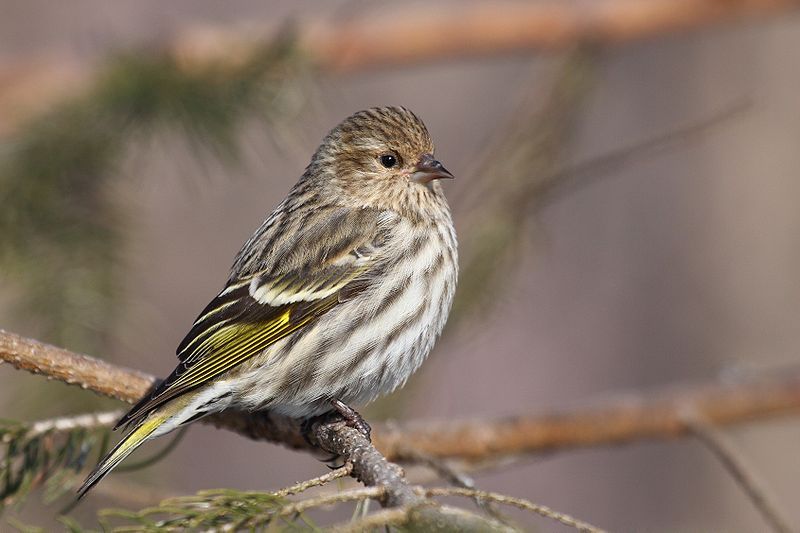
The pine siskin is a type of bird that can be found in North America. It belongs to the finch family, which includes other small birds like sparrows and goldfinches.
The pine siskin is known for its ability to migrate, meaning it travels from one place to another depending on the season. During the winter, the pine siskin’s range becomes very unpredictable.
Instead of following a specific pattern or staying in one place, it moves around in a sporadic manner.
This means that it can be difficult to predict where exactly these birds will be during the winter months. The reason behind the pine siskin’s sporadic winter range is not completely understood.
It is believed that factors like food availability and weather conditions play a role in determining their movements.
When certain food sources become scarce in one area, the birds may move to another location in search of better resources. The pine siskin’s winter range can vary from year to year.
One winter, they might be seen in large numbers in a particular region, while the next winter, they may be scarce or absent from the same area.
This unpredictability adds to the bird’s unique characteristics and makes it an interesting species to study. Researchers and bird enthusiasts often.
| Kingdom | Animalia |
| Phylum | Chordata |
| Clade | Dinosauria |
| Class | Aves |
| Order | Passeriformes |
| Family | Fringillidae |
| Genus | Spinus |
| Species | S. pinus |
18. Common Grackle

The common grackle is a type of bird that can be found in many parts of North America. It was first identified and described by a scientist named Carl Linnaeus in the year 1758. This bird belongs to a family of birds known as icterids.
One interesting thing about the common grackle is that it has three different subspecies. This means that there are slight variations in appearance among the different groups of these birds. When an adult common grackle is fully grown, it has certain distinct features.
For example, it has a long bill that is dark in colour. This bill is used by the bird to catch and eat its food. The common grackle also has pale yellow eyes, which add to its unique appearance. Another noticeable characteristic of the adult common grackle is its long tail.
This tail is an important part of the bird’s body, as it helps with balance and manoeuvrability during flight. It is worth noting that the common grackle is a fairly large bird compared to some other species.
Its size contributes to its visibility and makes it easier to spot in its natural habitat. The common grackle is an interesting bird species with distinct physical traits. It’s large numbers across the North.
| Kingdom | Animalia |
| Phylum | Chordata |
| Clade | Dinosauria |
| Class | Aves |
| Order | Passeriformes |
| Family | Icteridae |
| Genus | Quiscalus |
| Species | Q. quiscula |
19. Mourning Dove
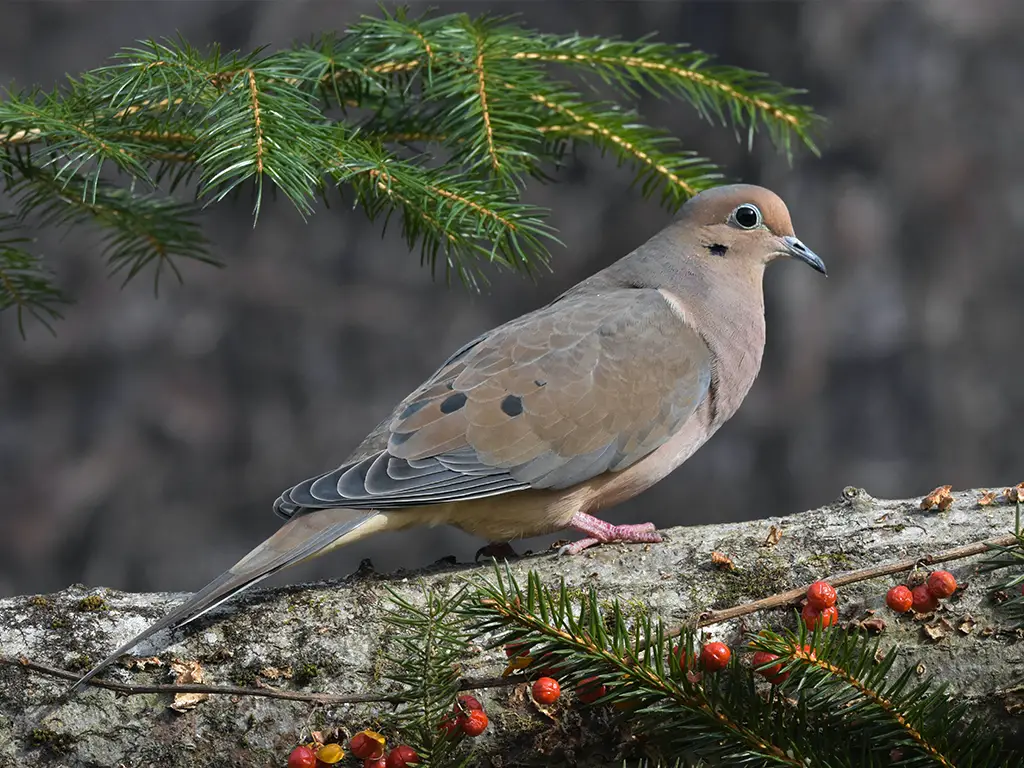
The mourning dove is a type of bird that belongs to the dove family called Columbidae. This bird is also known by different names, such as the American mourning dove, the rain dove, colloquially, the turtle dove.
In the past, it was referred to as the Carolina pigeon and Carolina turtledove. The mourning dove is a common species found in North and Central America. It is recognized for its soft, mournful cooing sound, which gives it its name.
This bird is known for its slender body and long, pointed tail. It has a greyish-brown colour with lighter shades on its underparts. One interesting fact about mourning doves is their ability to adapt to various habitats.
They can be found in different environments like forests, fields, urban areas, and even deserts. They are known to thrive in both rural and suburban settings. Mourning doves primarily feed on seeds, grains, and fruits.
They have a unique diet as they can swallow seeds whole and store them in their crop, a specialized part of their digestive system. This allows them to eat in one location and then retreat to a safer place to digest their food. These birds are monogamous, meaning they mate.
| Kingdom | Animalia |
| Phylum | Chordata |
| Clade | Dinosauria |
| Class | Aves |
| Order | Columbiformes |
| Family | Columbidae |
| Genus | Zenaida |
| Species | Z. macroura |
20. Song Sparrow
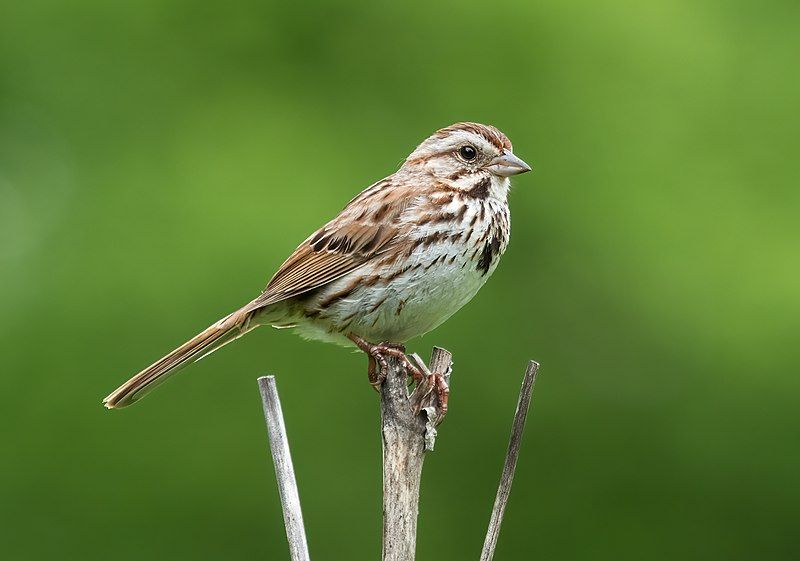
The song sparrow is a type of sparrow that can be found in North America. It is considered to be medium-sized in comparison to other sparrows. Out of all the sparrows native to North America, the song sparrow is known to be one of the most abundant species.
This means that there are a large number of song sparrows in the wild. Not only is the song sparrow abundant, but it is also quite variable. This means that there can be different variations or types of song sparrows. They may have slight differences in appearance or behaviour.
In addition to being abundant and variable, the song sparrow is also adaptable. This means that it can adjust well to different environments and conditions. It is able to thrive in various habitats, such as grasslands, marshes, and even urban areas.
The adaptability of the song sparrow allows it to have a wide range of distribution. It can be found in many parts of North America, from Canada down to Mexico. The song sparrow is a fascinating, medium-sized, abundant, variable, and adaptable bird.
Its ability to adapt to different environments has contributed to its success as a species in North America.
| Kingdom | Animalia |
| Phylum | Chordata |
| Clade | Dinosauria |
| Class | Aves |
| Order | Passeriformes |
| Family | Passerellidae |
| Genus | Melospiza |
| Species | M. melodia |
21. Horned Lark
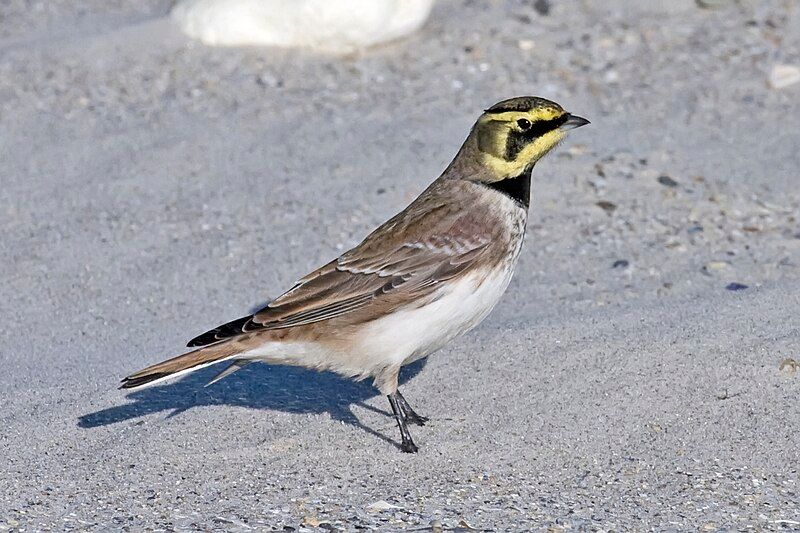
The horned lark is a type of bird that belongs to the lark family. It can be found in various parts of the world, specifically in the northern hemisphere.
In North America, this bird is commonly called the “horned lark,” while in Europe, it is known as the “shore lark.”This lark species is known for its distinctive features, including small “horns” or tufts of feathers on its head.
These horns give the bird its name and make it easily recognizable. However, it’s important to note that these “horns” are not actual horns but rather feather tufts. The horned lark’s habitat spans across different regions in the northern hemisphere.
It can be found in open areas such as grasslands, fields, and even sandy or rocky coastal areas.
These birds are highly adaptable and can be observed in diverse environments, from deserts to tundra. Regarding physical appearance, the horned lark has a brownish-grey body with streaks or patches of black. Its underparts are usually pale and lighter in colour.
These colours help the bird blend into its surroundings, providing camouflage and protection from potential predators.
| Kingdom | Animalia |
| Phylum | Chordata |
| Clade | Dinosauria |
| Class | Aves |
| Order | Passeriformes |
| Family | Alaudidae |
| Genus | Eremophila |
| Species | E. alpestris |
22. Woodpeckers
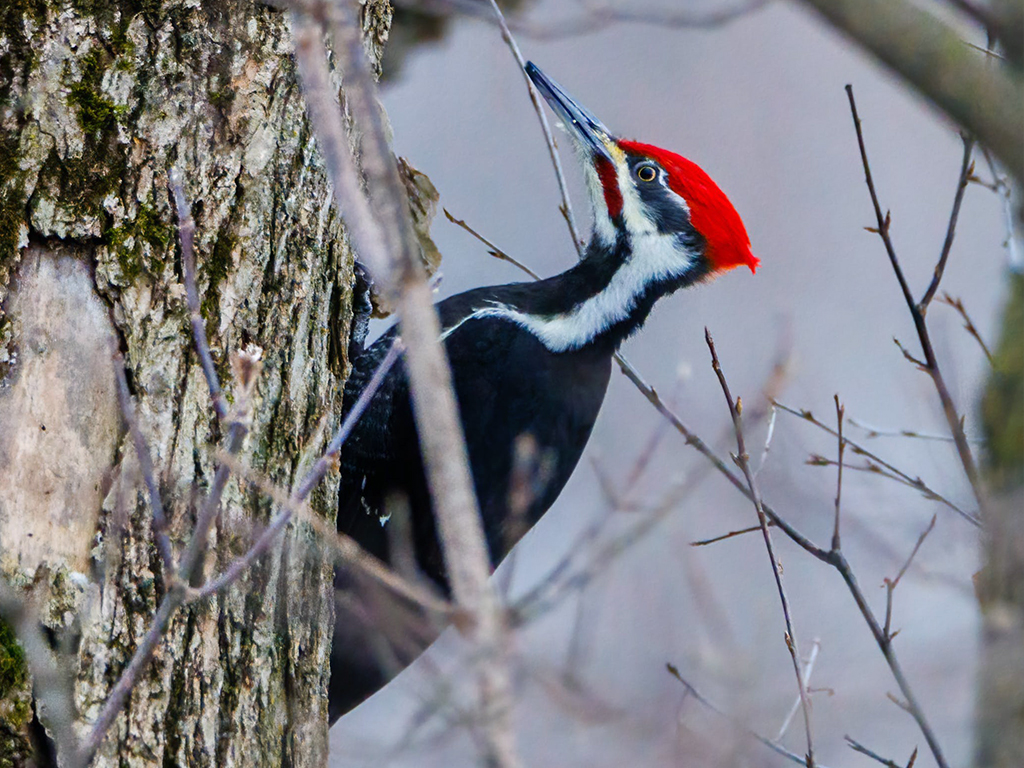
Woodpeckers belong to a bird family called Picidae. This family also includes other birds like piculets, wrynecks, and sapsuckers. Members of the Picidae family can be found all around the world, except in certain places.
Australia, New Guinea, New Zealand, Madagascar, and the extreme polar regions are the areas where these birds are not found. Woodpeckers are unique birds known for their ability to peck and drum on trees.
They have specially adapted beaks and strong neck muscles that allow them to strike trees repeatedly. This behaviour is used for feeding, communication, and establishing territories. Piculets are smaller woodpecker-like birds that belong to the Picidae family.
They have similar physical characteristics and behaviours as woodpeckers, but they are usually smaller in size. Wrynecks, another member of the Picidae family, are small, insect-eating birds with long, slender bills.
They are known for their ability to twist their necks in a snake-like fashion. Sapsuckers, also part of the Picidae family, are woodpeckers with unique feeding habits. They drill small holes in trees.
| Kingdom | Animalia |
| Phylum | Chordata |
| Clade | Dinosauria |
| Class | Aves |
| Order | Piciformes |
| Family | Picidae |
23. Red-Winged Blackbird
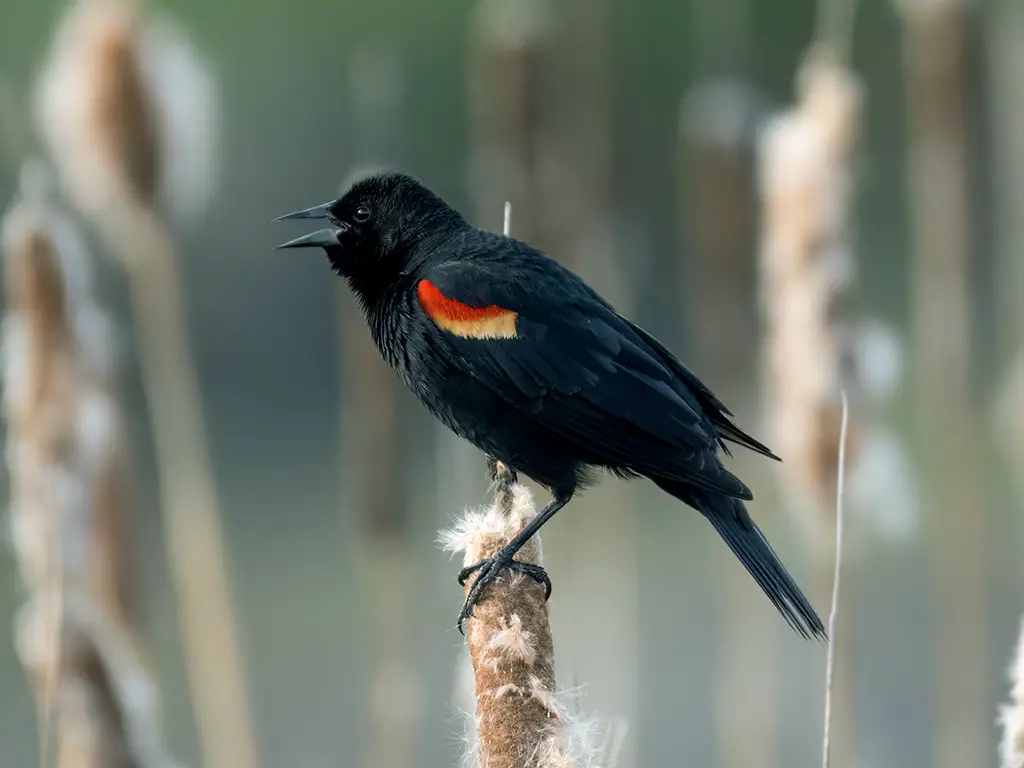
The red-winged blackbird is a type of bird that belongs to the passerine family called Icteridae.
It is commonly found in various parts of North America and a significant portion of Central America. Passerines are a diverse group of birds that are known for their musical and complex songs.
They have specialized vocal organs that allow them to produce a wide range of sounds. The red-winged blackbird is easily recognizable due to its distinct appearance.
The male red-winged blackbird has glossy black plumage and bright red patches on its wings, which give it its name.
On the other hand, the female red-winged blackbird has a more subdued appearance with brown feathers and streaks. These birds have a unique habitat preference, as they are commonly found in wetlands, marshes, and areas with tall grasses.
They are skilled at perching on tall plants and reeds, where they can easily spot their prey and potential predators. Red-winged blackbirds primarily feed on insects, seeds, and grains. They use their sharp beaks to catch insects on the fly and extract seeds from plants.
During the breeding season, they may also consume small vertebrates such as frogs and tadpoles.
| Kingdom | Animalia |
| Phylum | Chordata |
| Clade | Dinosauria |
| Class | Aves |
| Order | Passeriformes |
| Family | Icteridae |
| Genus | Agelaius |
| Species | A. phoeniceus |
24. Pileated Woodpecker
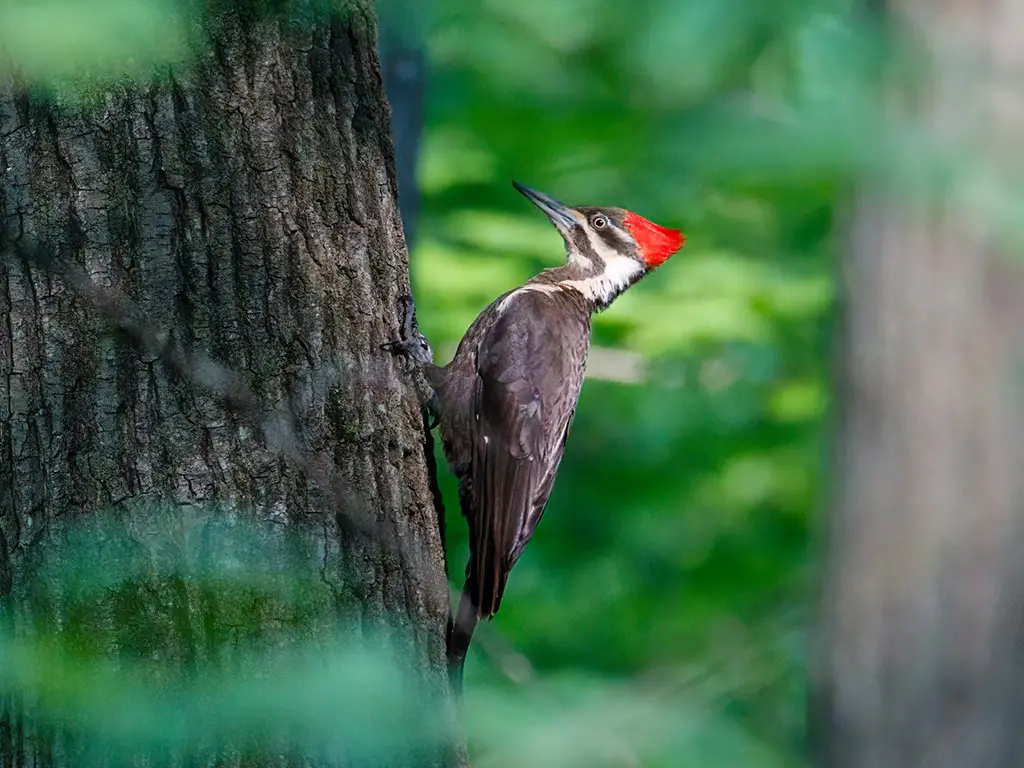
The pileated woodpecker is a type of bird that is mostly black and is found in North America. It is a relatively large bird compared to other woodpeckers. The pileated woodpecker mostly eats insects, which makes it an insectivore.
It usually lives in deciduous forests located in eastern North America. In addition to the eastern part of North America, the pileated woodpecker can also be found in the Great Lakes region. This means it can be seen in areas like Michigan, Minnesota, and the surrounding states.
The bird is also found in the boreal forests of Canada. These forests are characterized by mostly coniferous trees and are located in northern Canada. Furthermore, the pileated woodpecker can be spotted in certain areas along the Pacific Coast.
This means it can be found in states like Oregon and Washington. It is interesting to note that the bird’s habitat spans across different regions, showing its adaptability to various environments.
Overall, the pileated woodpecker is a fascinating bird that is native to North America. Its black feathers and relatively large size make it easy to identify. It prefers to live in deciduous forests.
| Kingdom | Animalia |
| Phylum | Chordata |
| Clade | Dinosauria |
| Class | Aves |
| Order | Piciformes |
| Family | Picidae |
| Genus | Dryocopus |
| Species | D. pileatus |
25. Brown Creeper
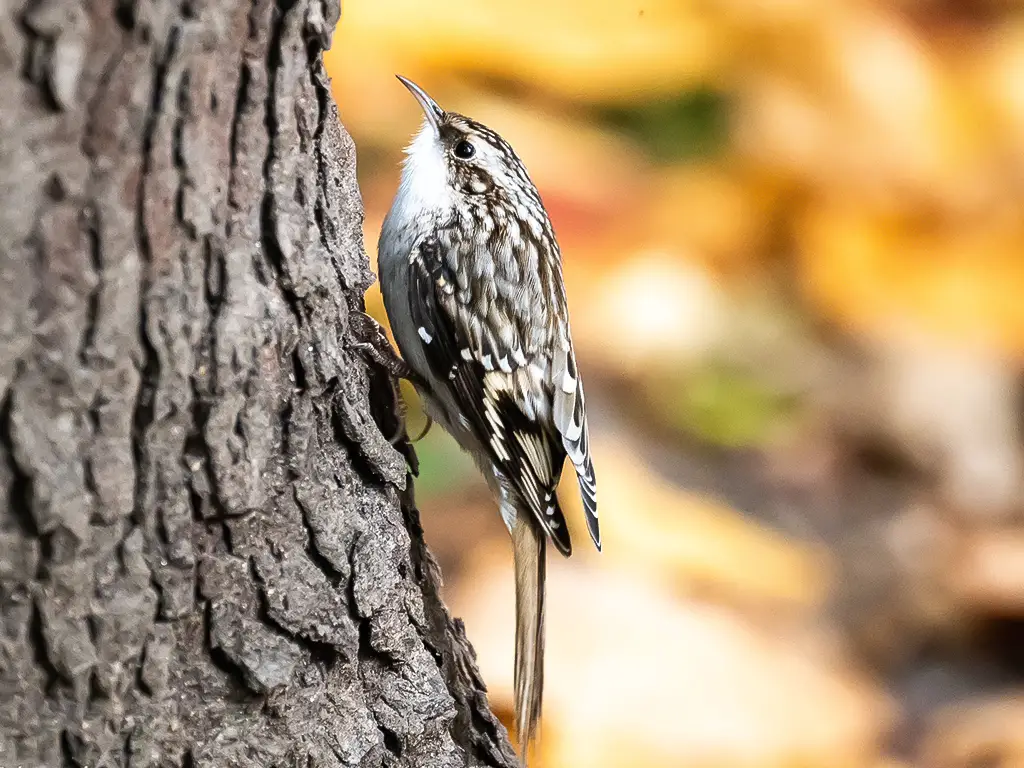
The brown creeper is a small bird that is also called the American treecreeper. It belongs to the treecreeper family called Certhiidae.
This bird is found only in North America, making it the only member of its family in this region. The brown creeper is known for its unique behaviour of climbing up tree trunks. It has a curved bill that helps it search for insects and spiders residing in the bark of trees.
The bird uses its stiff tail feathers as support while spiralling up the trees in a spiral pattern. The brown creeper has a distinct appearance. It has brown feathers that blend well with the bark of trees, providing camouflage and making it difficult to spot.
The bird has a white underbelly with streaks of brown, which helps it blend in with the tree trunks. This small songbird measures about 12-14 centimetres in length and weighs around 9-14 grams. It has a wingspan of approximately 18-20 centimetres.
The brown creeper’s body is slender, allowing it to manoeuvre easily among trees. These birds are primarily found in mature forests with a dense canopy. They prefer habitats with a mix of deciduous and coniferous.
| Kingdom | Animalia |
| Phylum | Chordata |
| Clade | Dinosauria |
| Class | Aves |
| Order | Passeriformes |
| Family | Certhiidae |
| Genus | Certhia |
| Species | C. americana |
26. Cedar Waxwing
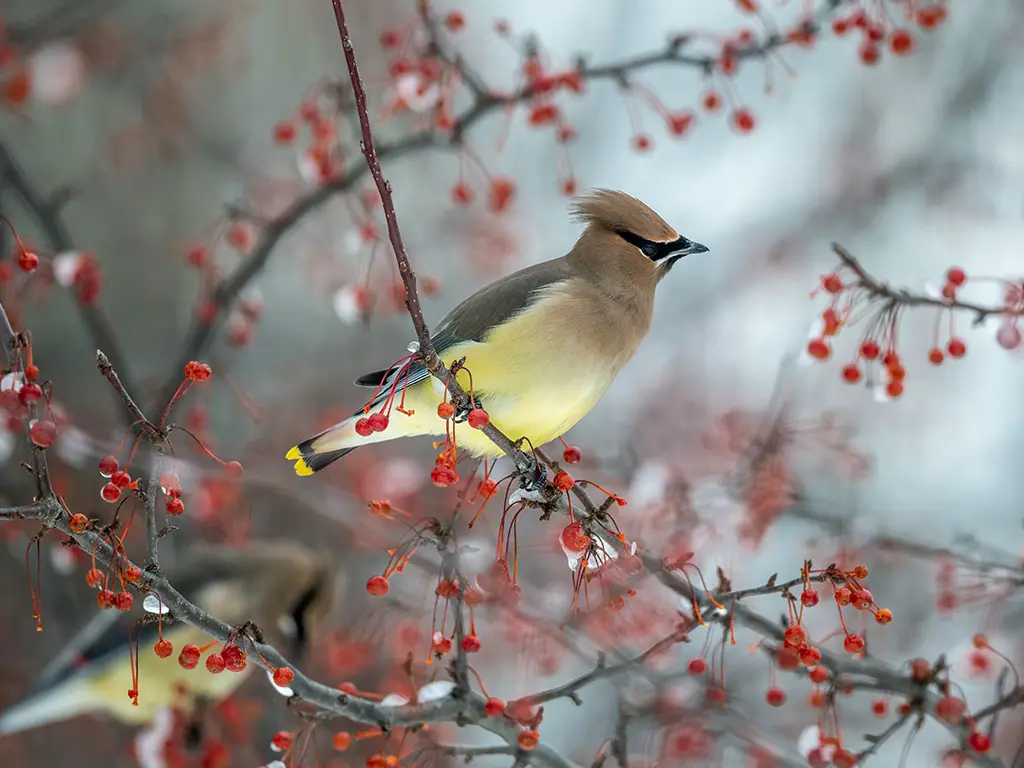
The cedar waxwing is a type of bird that belongs to the waxwing family of passerine birds known as Bombycillidae. Passerine birds are perching birds, which means they have feet adapted for gripping branches.
The cedar waxwing is a medium-sized bird with a distinctive appearance. Its feathers are mostly brown, grey, and yellow in colour.
These colours help the bird blend well with its surroundings, making it harder for predators to spot it. One of the most unique features of the cedar waxwing is its wings. The bird gets its name from the wax-like tips on its wings.
These wing tips look like they have been dipped in wax, giving the bird a fascinating and memorable look. The wax-like wing tips serve a purpose for the cedar waxwing. They are actually specialized feathers that help the bird in various ways.
The waxy substance on the wing tips repels water, allowing the bird to fly more easily in wet weather conditions. It also helps the bird glide smoothly through the air, reducing air resistance. Another interesting aspect of the cedar waxwing is its diet.
This bird primarily feeds on fruits, such as berries, and small fruits, like cherries. It has a unique adaptation in it.
| Kingdom | Animalia |
| Phylum | Chordata |
| Clade | Dinosauria |
| Class | Aves |
| Order | Passeriformes |
| Family | Bombycillidae |
| Genus | Bombycilla |
| Species | B. cedrorum |
27. Eastern Bluebird
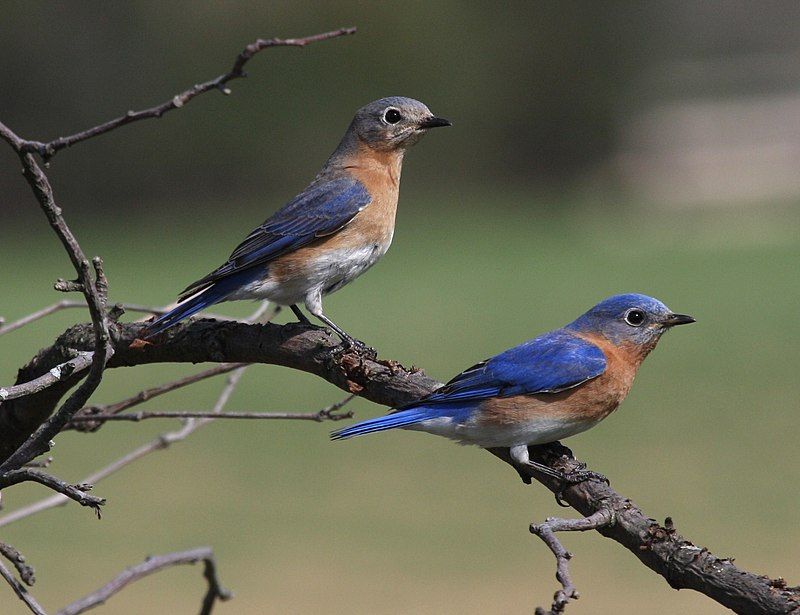
The eastern bluebird is a type of bird that is native to North America. It is known for its ability to migrate or travel from one place to another.
It prefers to live in open woodlands, farmlands, orchards with plenty of trees and open spaces. One notable feature of the eastern bluebird is its bright blue breeding plumage.
The male bluebird has this vibrant blue colour on its feathers during the breeding season. This makes it easy to spot and observe when it is perched on a wire or in an open area.
Many birdwatchers, also known as birders, find the eastern bluebird to be a favourite species to observe because of its striking appearance. The blue colour of the male bluebird’s feathers is often associated with the breeding season.
It is a way for the male to attract a mate and signal its reproduction readiness.
The bright plumage acts as a visual cue for potential mates, indicating that the male is healthy and capable of producing offspring. In addition to its blue feathers, the eastern bluebird has other distinctive physical characteristics.
It is smaller than other birds, allowing it to maneuver easily in its woodland and farmland habitats.
| Kingdom | Animalia |
| Phylum | Chordata |
| Clade | Dinosauria |
| Class | Aves |
| Order | Passeriformes |
| Family | Turdidae |
| Genus | Sialia |
| Species | S. sialis |
28. White-Crowned Sparrow
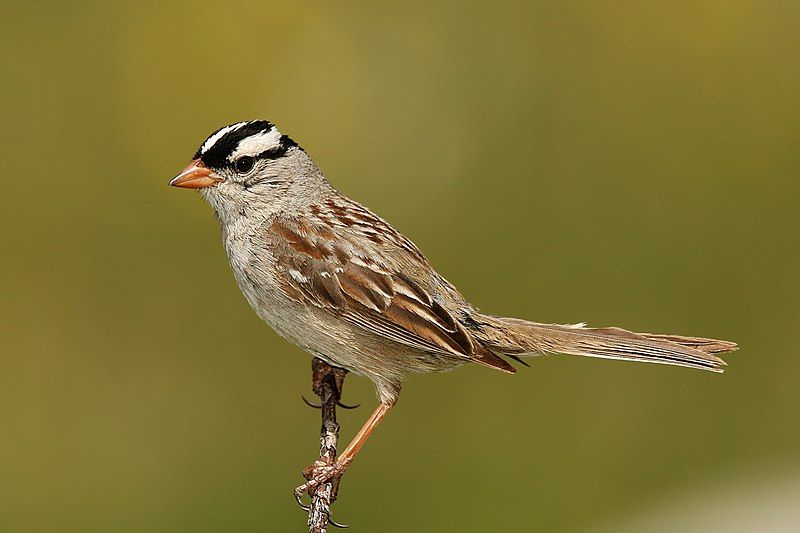
The white-crowned sparrow is a type of bird that is found in North America. It belongs to the passerine bird family, which means it is a perching bird.
This species is not too big or too small but falls into the category of medium-sized birds. One distinctive feature of the white-crowned sparrow is its grey face. The color of its face is different from the rest of its body, making it easy to identify.
The grey colour gives the bird a unique and interesting appearance. Another characteristic of this species is the black and white streaking on its upper head. The streaks create a pattern that adds to the bird’s overall appearance.
These streaks are alternating black and white lines, giving the bird a striking and beautiful look. The black and white streaking on the white-crowned sparrow’s upper head is a notable feature because it contrasts with the rest of its body.
This contrast makes the bird stand out and catch the eye of observers. Seeing how nature has designed this bird with such distinct markings is interesting. The white-crowned sparrow’s grey face and black and white streaking on the upper head are unique to this species.
These characteristics help distinguish it from others.
| Kingdom | Animalia |
| Phylum | Chordata |
| Clade | Dinosauria |
| Class | Aves |
| Order | Passeriformes |
| Family | Passerellidae |
| Genus | Zonotrichia |
| Species | Z. leucophrys |
29. Rusty Blackbird
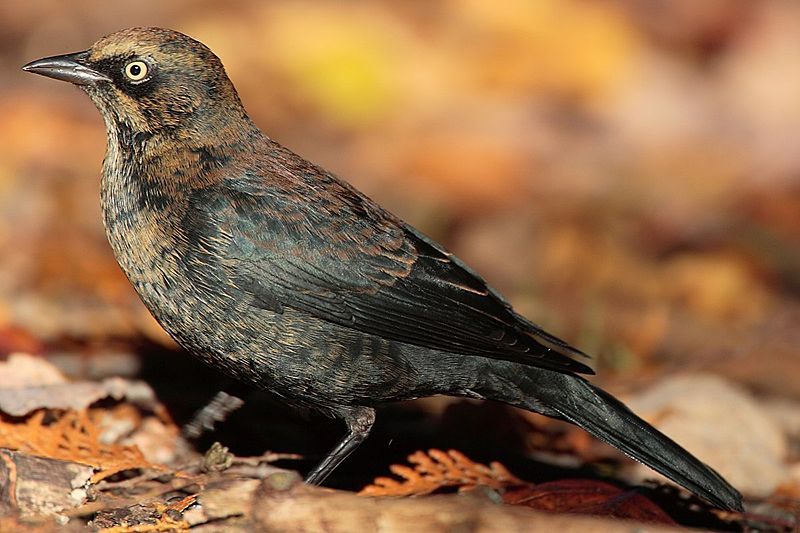
The rusty blackbird is a type of blackbird that can be found in the New World. It is closely related to grackles, another type of bird. In terms of size, the rusty blackbird is considered to be medium-sized.
This means that it is not too big or too small but falls somewhere in the middle. Regarding its preferred habitat, the rusty blackbird likes to be in wet forested areas. These areas provide the bird with the conditions it needs to thrive.
The rusty blackbird can be found during the breeding season, which occurs in the boreal forest and muskeg across northern Canada. This is where they make their nests and raise their young.
However, during winter, the rusty blackbird migrates southeast to the United States. It moves to a different location in search of more favourable conditions for survival. This migration pattern is common among many bird species.
They often travel to different areas depending on the time of year, food availability, and resources. Overall, the rusty blackbird is an interesting bird found in Canada and the United States.
It has specific preferences for its habitat and exhibits migratory behaviour.
| Kingdom | Animalia |
| Phylum | Chordata |
| Clade | Dinosauria |
| Class | Aves |
| Order | Passeriformes |
| Family | Icteridae |
| Genus | Euphagus |
| Species | E. carolinus |
30. Sharp-Shinned Hawk
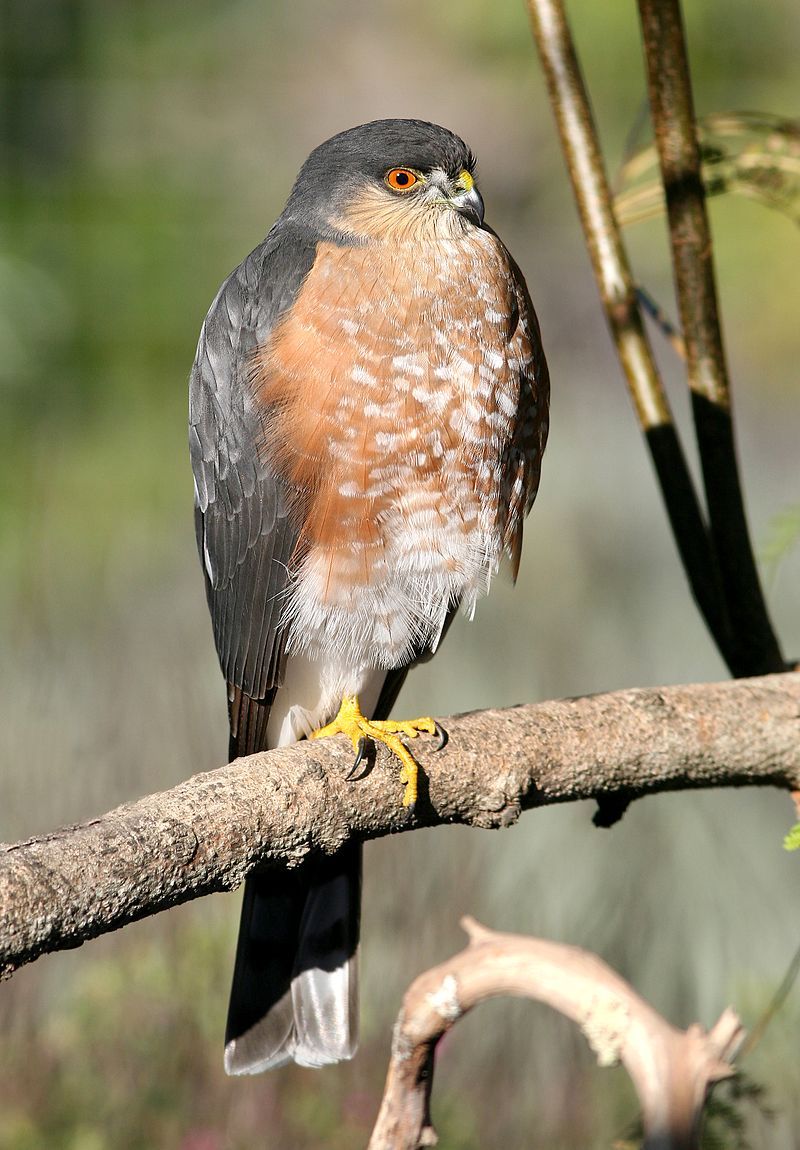
The sharp-shinned hawk, also known as a sharpie, is a small hawk type. In fact, the males of this species are the smallest hawks found in both the United States and Canada.
However, it’s worth noting that the sharp-shinned hawk is still larger than certain Neotropical species, such as the tiny hawk. This particular species of hawk is commonly referred to as a sharpie due to its sharp features and small size.
Although it is small compared to other hawks, it is important to understand that it is still larger than certain types of hawks found in the Neotropics, a region of the Americas encompassing Central and South America.
The sharp-shinned hawk’s size is noteworthy because it is the smallest species in the United States and Canada.
This means that the sharp-shinned hawk stands out for its diminutive size compared to other hawks that inhabit these regions.
Furthermore, it is interesting to consider that despite being small in the context of North American hawks, the sharp-shinned hawk is still larger on average than some Neotropical species, such as the tiny hawk.
This suggests that while the sharp-shinned hawk may be a small relative.
| Kingdom | Animalia |
| Phylum | Chordata |
| Clade | Dinosauria |
| Class | Aves |
| Order | Accipitriformes |
| Family | Accipitridae |
| Genus | Accipiter |
| Species | A. striatus |
31. American Kestrel
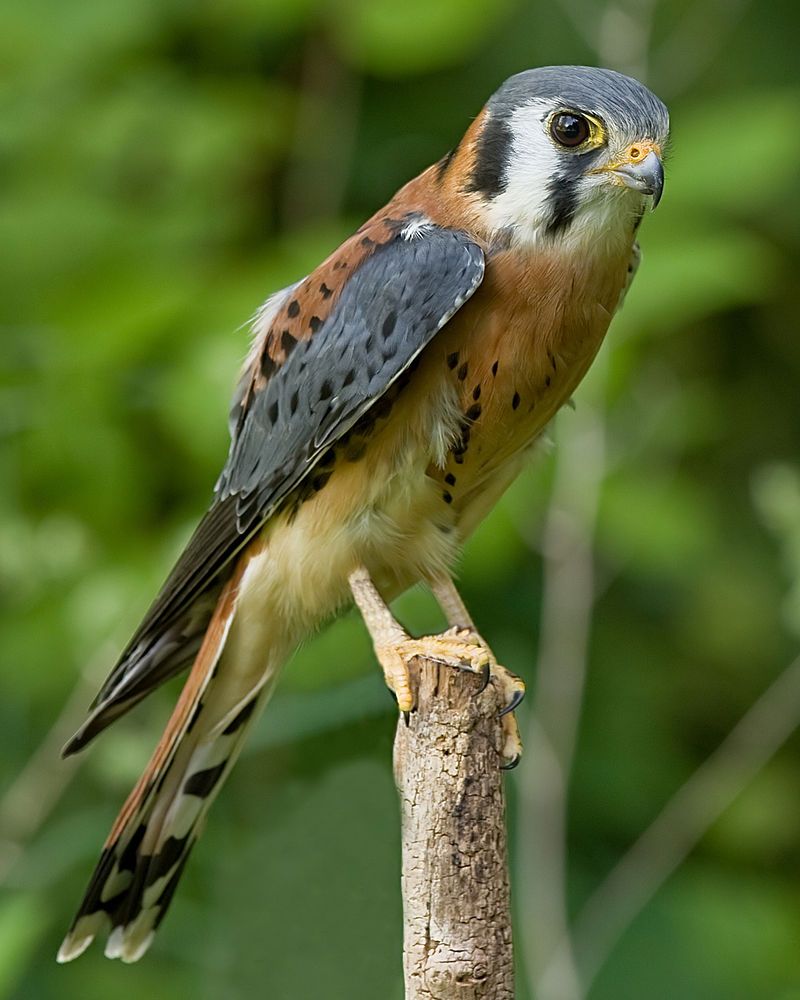
The American kestrel is a type of falcon that can also be known as the sparrow hawk. It is found in North America and is the region’s smallest and most common falcon.
The size of the American kestrel can vary depending on the subspecies and the sex of the bird.
Generally, there is a two-to-one range in size between different individuals. When it comes to size, the American kestrel can range from being as small as a blue jay to as large as a mourning dove.
This means that some individuals can weigh as much as a blue jay, while others can be as heavy as a mourning dove. The variation in size within the American kestrel population can be attributed to differences in subspecies and also between males and females.
This means that females may generally be larger than males, and different subspecies may have different average sizes. Interestingly, despite this size variation, the American kestrel remains the smallest falcon in North America.
This indicates that even the largest individuals of this species are still relatively small compared to other falcons found in the region. In conclusion, the American kestrel is also known as the sparrow.
| Kingdom | Animalia |
| Phylum | Chordata |
| Clade | Dinosauria |
| Class | Aves |
| Order | Falconiformes |
| Family | Falconidae |
| Genus | Falco |
| Species | F. sparverius |
32. White-Throated Sparrow
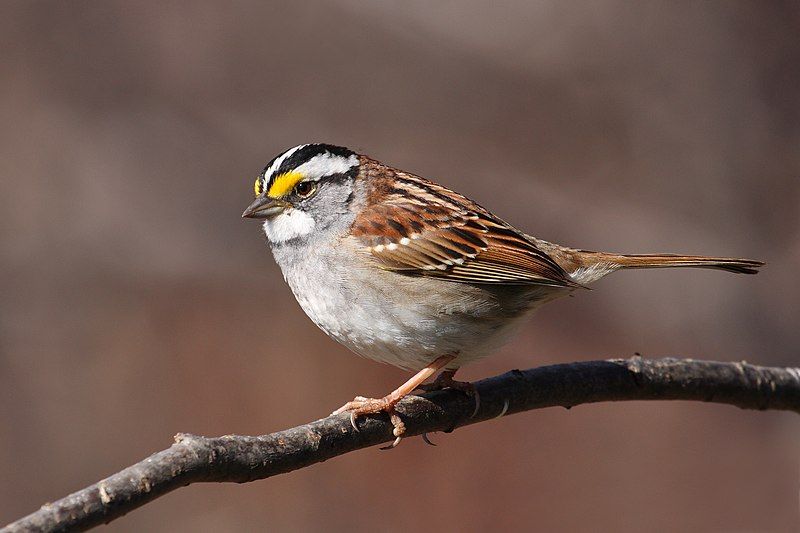
The white-throated sparrow is a type of bird that belongs to the passerine family called Passerellidae. This family of birds is commonly known as New World sparrows. Passerines are a diverse group of birds that make up more than half of all bird species.
They are known for their unique ability to perch and grip onto branches with their feet. The white-throated sparrow is easily distinguished by the white patch on its throat. This feature gives the bird its name.
These sparrows are native to North America and can be found throughout the continent, from Canada to Mexico. They are migratory birds, meaning they travel long distances during certain times of the year.
During the breeding season, white-throated sparrows are known for their distinct song, which can be described as a whistling “Oh sweet Canada, Canada, Canada.” This song helps them attract mates and establish their territory.
White-throated sparrows are relatively small birds, measuring about 6 to 7 inches long. They have a plump body with a rounded head and a short tail. Their plumage consists of a combination of grey, brown, and black feathers.
| Kingdom | Animalia |
| Phylum | Chordata |
| Clade | Dinosauria |
| Class | Aves |
| Order | Passeriformes |
| Family | Passerellidae |
| Genus | Zonotrichia |
| Species | Z. albicollis |
33. Grey Partridge
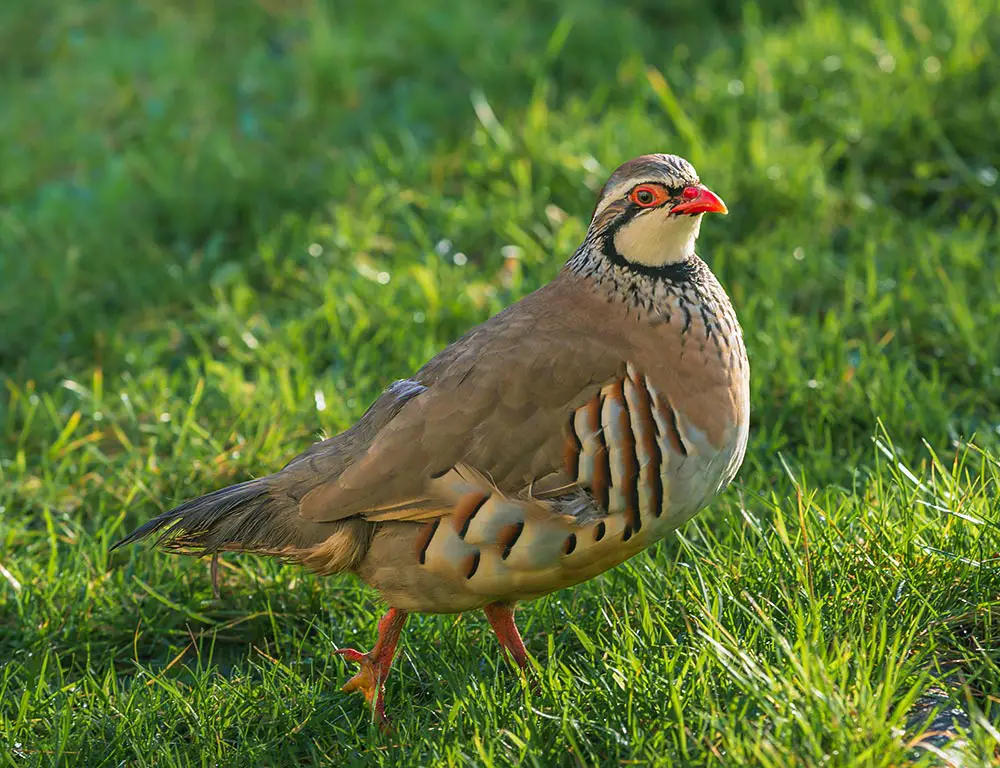
The grey partridge is a type of gamebird that belongs to the pheasant family called Phasianidae. It is also known by various other names such as the grey-legged partridge, English partridge, Hungarian partridge, or hun.
This bird falls under the category of gallinaceous birds, which are a group of birds within the order Galliformes.
The scientific name of the grey partridge is derived from Latin and means “partridge.” It is interesting to note that this name itself comes from the Ancient Greek word “perdix.”
This shows how the scientific names of organisms often have roots in ancient languages. The grey partridge is a popular gamebird, which means it is hunted for sport or for food.
It is often found in Europe and certain parts of Asia. This bird has a distinctive appearance, with its grey feathers and long legs.
It is known for its ability to fly short distances and its preference for living in open grasslands or farmlands. The grey partridge is sought after by hunters and admired for its beauty and presence in the natural world.
Many people enjoy observing these birds in their natural habitats. Their presence adds to the biodiversity and richness of the ecosystems.
| Kingdom | Animalia |
| Phylum | Chordata |
| Clade | Dinosauria |
| Class | Aves |
| Order | Galliformes |
| Family | Phasianidae |
| Genus | Perdix |
| Species | P. perdix |
34. Savannah Sparrow
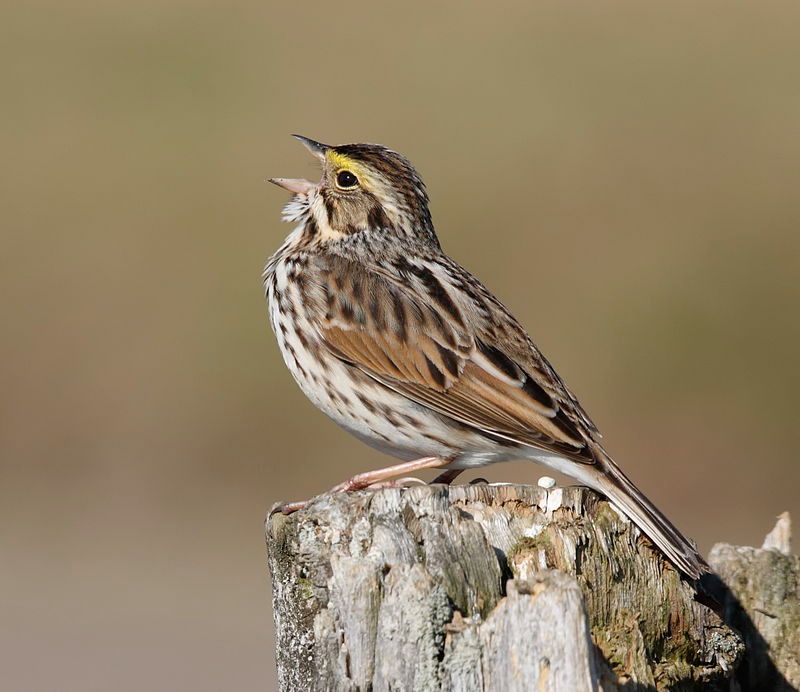
The Savannah sparrow is a small bird found in the New World. It belongs to the sparrow family and is known for its distinct features. In the past, it was the only species within the Passerculus genus.
However, over time, further research and studies have led to a change in this classification. Currently, the Savannah sparrow is still recognized as a distinct species. It is widely accepted as a member of the Passerculus genus.
This means that it shares common characteristics and traits with other species within this group.
However, it is important to note that it is now this genus’s only widely accepted member. Specifying species is a complex process that involves careful examination and analysis.
Scientists study various factors such as physical characteristics, behaviour, and genetic information to determine the relationships between different organisms.
As more information becomes available, the understanding of species and their classifications can change. In the case of the Savannah sparrow, further research might have revealed new information about its genetic makeup or behaviour.
This could have led to a reevaluation of its classification within the Passerculus genus. Other species that were previously considered members of this group might have been found to differ significantly, resulting in their exclusion from the genus.
| Kingdom | Animalia |
| Phylum | Chordata |
| Clade | Dinosauria |
| Class | Aves |
| Order | Passeriformes |
| Family | Passerellidae |
| Genus | Passerculus |
| Species | P. sandwichensis |
35. Harris’s Sparrow
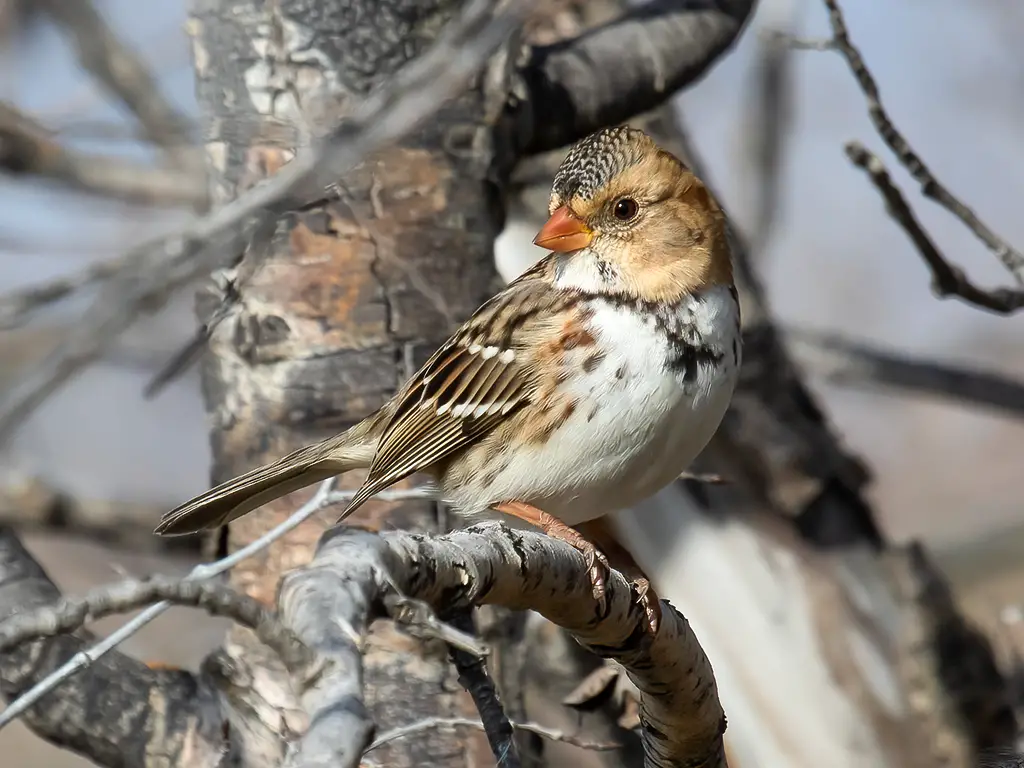
The Harris’s sparrow is a type of bird that belongs to the sparrow family. It is known for being quite large compared to other sparrows. This bird has a specific breeding habitat, which is located in the northern part of central Canada.
In fact, it is the only type of bird that breeds exclusively in Canada. This makes it special and unique because it has not been found breeding anywhere else in the world. During the winter season, the Harris’s sparrow migrates to different regions in the United States.
Specifically, it travels to the Great Plains states. These states include southern South Dakota, all the way down to central Texas. The sparrow finds these areas to be more suitable and comfortable during the colder months.
It is interesting to note that Harris’s sparrow has a specific migration pattern. It spends its breeding season in Canada and then travels southwards to the United States for the winter.
This pattern allows the bird to adapt to different climates and find suitable conditions for survival throughout the year. The migration of the Harris sparrow is important for its survival and plays a significant role in maintaining the balance of ecosystems.
By travelling to different regions, the sparrow helps in pollination.
| Kingdom | Animalia |
| Phylum | Chordata |
| Clade | Dinosauria |
| Class | Aves |
| Order | Passeriformes |
| Family | Passerellidae |
| Genus | Zonotrichia |
| Species | Z. querula |
36. Wrens
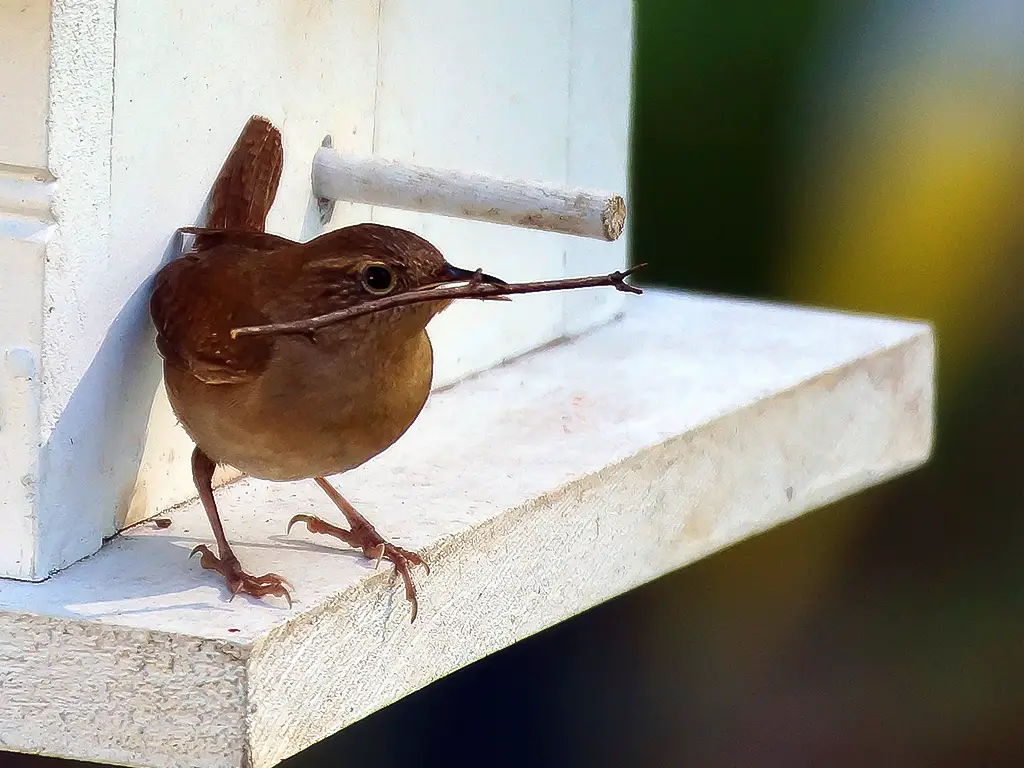
Wrens are a type of bird that belongs to the family Troglodytidae. They are mainly found in the New World, which includes the Americas.
There are about 88 different species of wrens, and they are categorized into 19 different genera, which is a higher taxonomic rank. Interestingly, there is only one species of wren, called the Eurasian wren, that can be found in the Old World.
The Old World refers to regions such as Europe, Asia, and Africa. In English-speaking countries, this particular wren is called just “wren.”This is because the Eurasian wren is believed to be the original wren species that gave rise to the name.
Over time, as people encountered different species of wrens in the New World, they started using more specific names to differentiate them.
However, the name “wren” stuck with the Eurasian species because it was discovered and named first. So, when people in Anglophone regions say “wren,” they are usually referring to the Eurasian wren.
It is essential to note that this is a regional naming convention and may not be true in other languages or parts of the world.
| Kingdom | Animalia |
| Phylum | Chordata |
| Clade | Dinosauria |
| Class | Aves |
| Order | Passeriformes |
| Family | Troglodytidae |
37. Baltimore Oriole
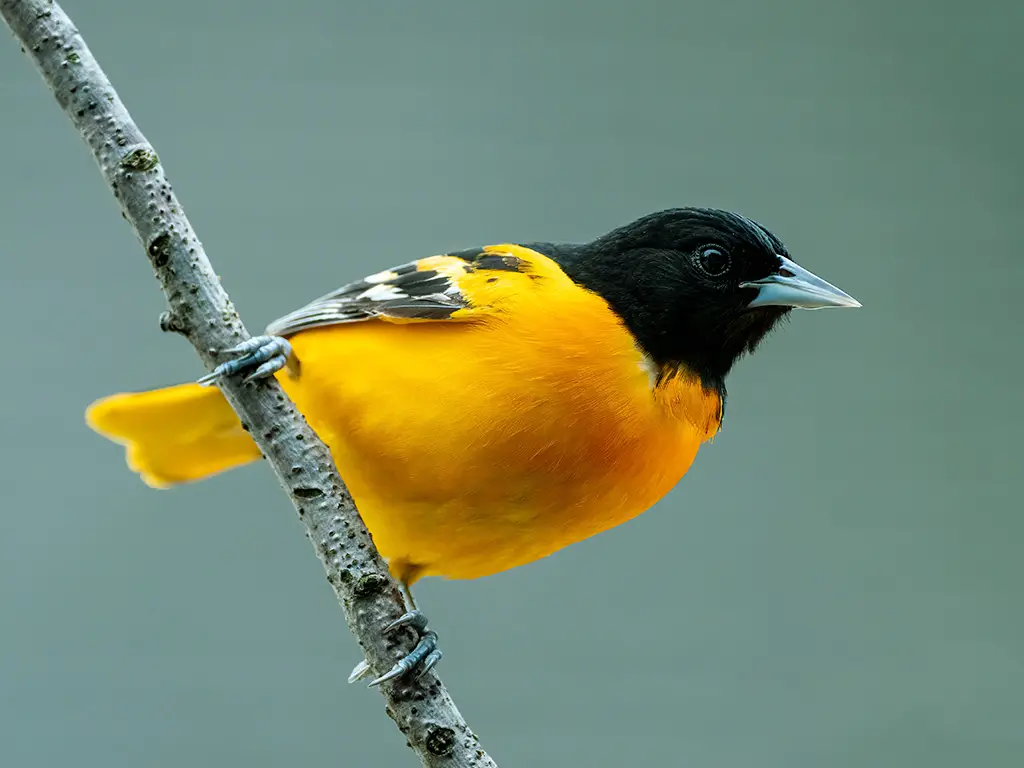
The Baltimore oriole is a type of bird that belongs to the icterid blackbird family. It is found commonly in eastern parts of North America.
This bird is known for its tendency to migrate during the breeding season. The reason behind its name is quite fascinating.
It is said that the Baltimore oriole got its name because of the similarity between the male’s colours and the coat-of-arms of Lord Baltimore, who lived in the 17th century.
This suggests that the bird’s vibrant and distinct colours reminded people of the coat of arms. The male Baltimore oriole is particularly known for its striking appearance. It has bright orange plumage on its underparts, while its head, back, and wings are black.
These contrasting colours make the male Baltimore oriole stand out in its habitat. On the other hand, the female Baltimore oriole has a more subdued appearance. Its plumage is primarily yellowish-brown, which helps it blend in better with its surroundings.
This difference in appearance between males and females is a common characteristic among many bird species. In addition to its striking appearance, the Baltimore oriole is also known for its beautiful song. The male bird sings a complex.
| Kingdom | Animalia |
| Phylum | Chordata |
| Clade | Dinosauria |
| Class | Aves |
| Order | Passeriformes |
| Family | Icteridae |
| Genus | Icterus |
| Species | I. galbula |
38. Cooper’s Hawk
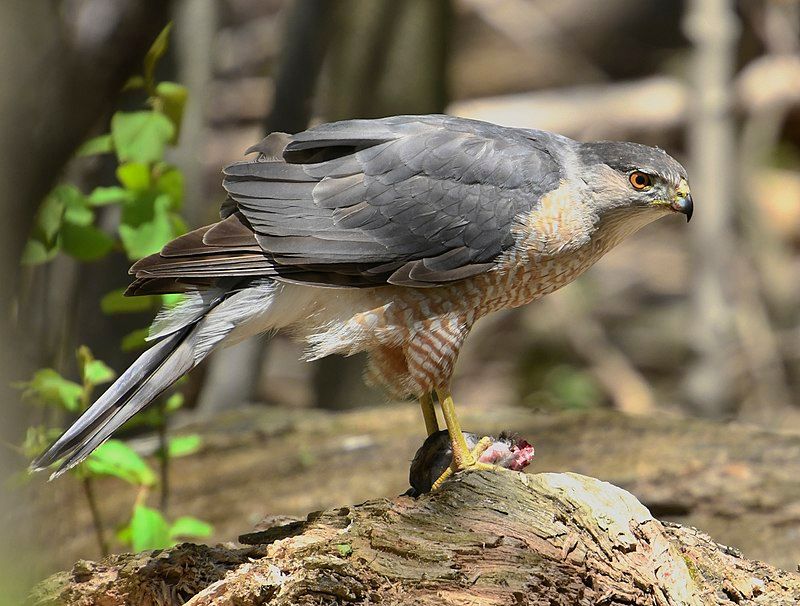
The Cooper’s hawk is a type of hawk that can be found in North America. It is considered to be a medium-sized bird.
This species is native to the continent and is commonly found in various regions ranging from southern Canada all the way down to Mexico. One interesting characteristic of the Cooper’s hawk is its size.
It falls into the category of medium-sized hawks, which means it is neither too big nor too small. This size allows the hawk to adapt and survive in different habitats across North America. The distribution of the Cooper’s hawk is quite extensive.
It can be found in different parts of North America, including southern Canada, the United States, and Mexico.
This wide range of habitats gives the hawk ample opportunities to thrive and establish its presence in various ecosystems. Despite its widespread distribution, the Cooper’s hawk is not evenly distributed throughout its range.
It tends to be more common in certain areas and less abundant in others. This variation in population density might be influenced by factors such as the availability of prey, nesting sites, and overall habitat suitability. The Cooper’s hawk is known for its hunting skills.
It primarily feeds on small to medium-sized birds, which it catches by surprise with speed and agility. This hawk is well-adapted.
| Kingdom | Animalia |
| Phylum | Chordata |
| Clade | Dinosauria |
| Class | Aves |
| Order | Accipitriformes |
| Family | Accipitridae |
| Genus | Accipiter |
| Species | A. cooperii |
39. Snow Bunting
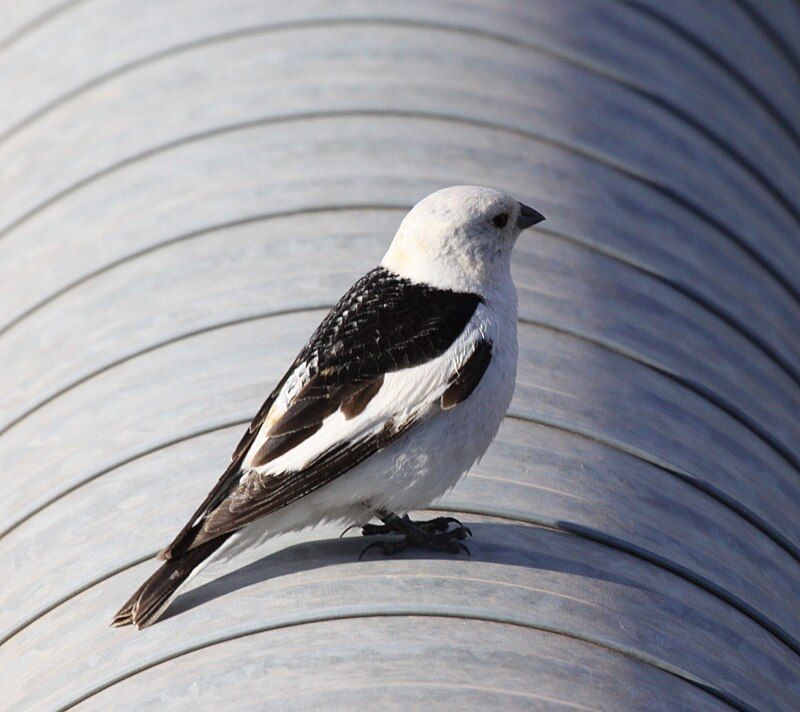
The snow bunting is a type of bird that belongs to the passerine family called Calcariidae. This family includes various species of birds that are known for their perching abilities. Unlike many other birds, the snow bunting is specially adapted to survive in the Arctic region.
It is considered an Arctic specialist because its unique features help it thrive in this cold and harsh environment. One of the distinctive characteristics of the snow bunting is its circumpolar Arctic breeding range.
This means that it can be found breeding throughout the entire Arctic region in the northern hemisphere. It has the ability to survive and reproduce in areas with extreme temperatures and limited resources.
The circumpolar Arctic breeding range of the snow bunting indicates that it is well adapted to the Arctic conditions. It can be found in various countries, such as Canada, Greenland, Iceland, Russia, and Norway.
In these regions, it is able to find suitable breeding grounds and sufficient food sources. During the breeding season, the snow bunting constructs its nests on the ground in open areas such as tundra or rocky slopes.
This nesting behaviour helps protect the eggs and young birds from predators, as the open environment allows for better visibility.
| Kingdom | Animalia |
| Phylum | Chordata |
| Clade | Dinosauria |
| Class | Aves |
| Order | Passeriformes |
| Family | Calcariidae |
| Genus | Plectrophenax |
| Species | P. nivalis |
40. Sandhill Crane
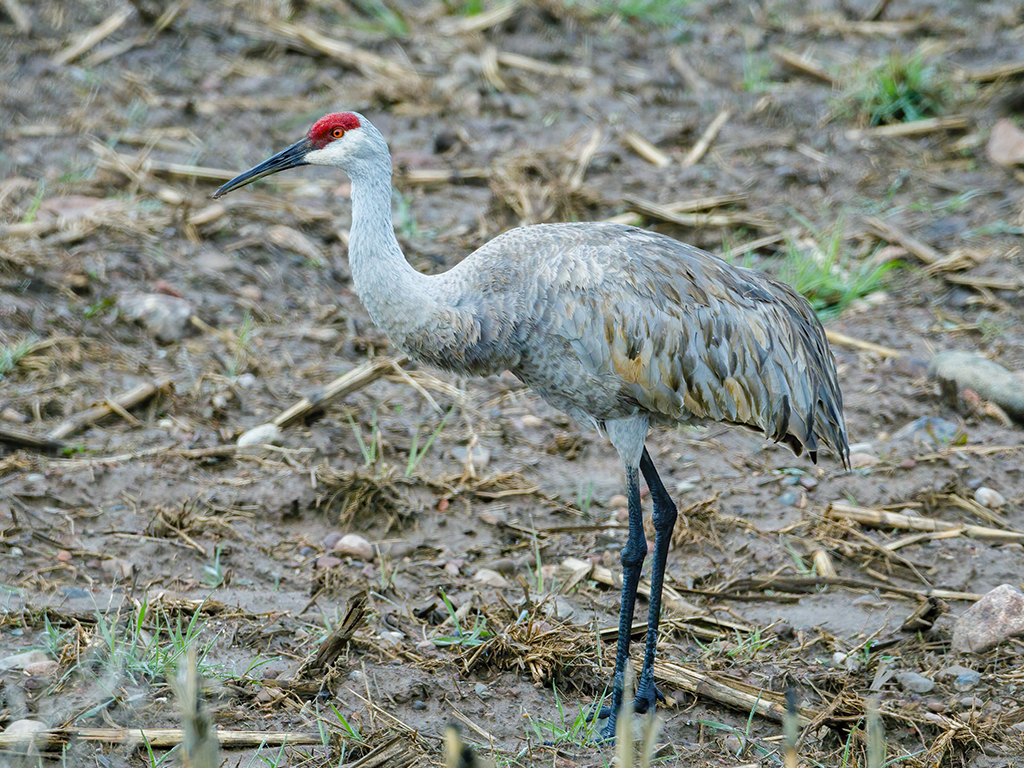
The sandhill crane is a type of bird. It is a large crane that can be found in North America and extreme northeastern Siberia. Its common name comes from the habitat it prefers, which is similar to the Platte River. This river is located on the edge of Nebraska’s Sandhills.
The Sandhills are part of the American Great Plains. The sandhill crane is known for its distinctive appearance and behaviour. It has long legs and a long neck, which allows it to stand tall and walk gracefully. The bird has a greyish-brown body with patches of red on its head.
It also has a long, pointed beak that it uses to catch and eat its food. These cranes are highly adapted to living in wetland areas. They can be found in marshes, bogs, and shallow lakes. The Platte River, for example, provides an ideal habitat for them.
The river’s sandbars, wetlands, and surrounding grasslands offer a perfect environment for the sandhill cranes to forage and rest. During their migration, sandhill cranes form large flocks that can number in the thousands.
They fly in a V-formation, using the air currents to conserve energy.
| Kingdom | Animalia |
| Phylum | Chordata |
| Clade | Dinosauria |
| Class | Aves |
| Order | Gruiformes |
| Family | Gruidae |
| Genus | Antigone |
| Species | A. canadensis |
41. Pied-Billed Grebe
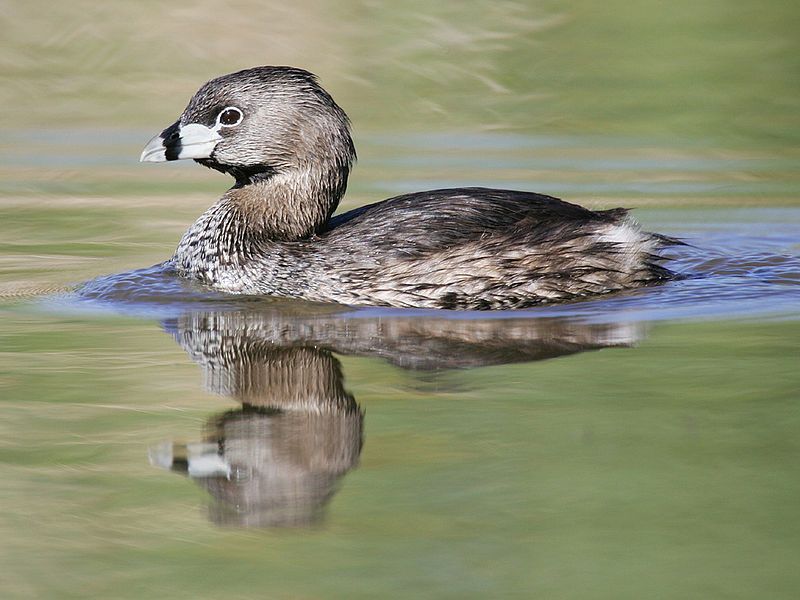
The pied-billed grebe belongs to the grebe family, which consists of water birds. These birds are commonly found in various ponds across the Americas.
They have adapted to living near water bodies and are well-suited to their aquatic habitat. With a unique appearance, the pied-billed grebe stands out among other grebe species. Its most distinctive feature is its bill, which is pied, meaning it has a bicoloured appearance.
This black and white bill gives the bird its name. This characteristic helps differentiate it from other grebes and is a key identifying feature. The pied-billed grebe, primarily residing in ponds, showcases a preference for freshwater habitats.
Ponds provide them with ample resources such as food and nesting sites. These birds have a specialized diet, feeding on various aquatic organisms like small fish, crustaceans, insects, and amphibians.
Their ability to dive and swim underwater aids them in capturing their prey. Due to its unique physical adaptations, the pied-billed grebe is skilled in swimming and diving.
It possesses lobed toes on its feet, which are connected with webbing, enabling efficient movement through water. These lobes allow the bird to paddle and propel itself underwater.
| Kingdom | Animalia |
| Phylum | Chordata |
| Clade | Dinosauria |
| Class | Aves |
| Order | Podicipediformes |
| Family | Podicipedidae |
| Genus | Podilymbus |
| Species | P. podiceps |
42. American White Pelican

The American white pelican is a type of bird that lives in water and can fly high in the sky. It belongs to the order Pelecaniformes, which includes other water birds like pelicans and herons.
This pelican is found in interior regions of North America, where it breeds or lays its eggs. During the breeding season, they choose areas away from the coasts and make nests on the ground. These nests are often made of sticks and twigs.
However, when winter comes, the American white pelican starts to migrate or travel to different places. It moves south from its breeding grounds in North America. The pelicans fly long distances, sometimes even as far as Costa Rica, which is a country in Central America.
The reason behind this migration is to find warmer weather and more food. The water may freeze in colder regions, making it difficult for the pelicans to find fish to eat.
By moving south, they can find open water and continue to feed on fish, their main food source. During the winter months, the American white pelican can be seen near the coasts, such as along the shores of the Gulf of Mexico.
| Kingdom | Animalia |
| Phylum | Chordata |
| Clade | Dinosauria |
| Class | Aves |
| Order | Pelecaniformes |
| Family | Pelecanidae |
| Genus | Pelecanus |
| Species | P. erythrorhynchos |
43. Double-Crested Cormorant
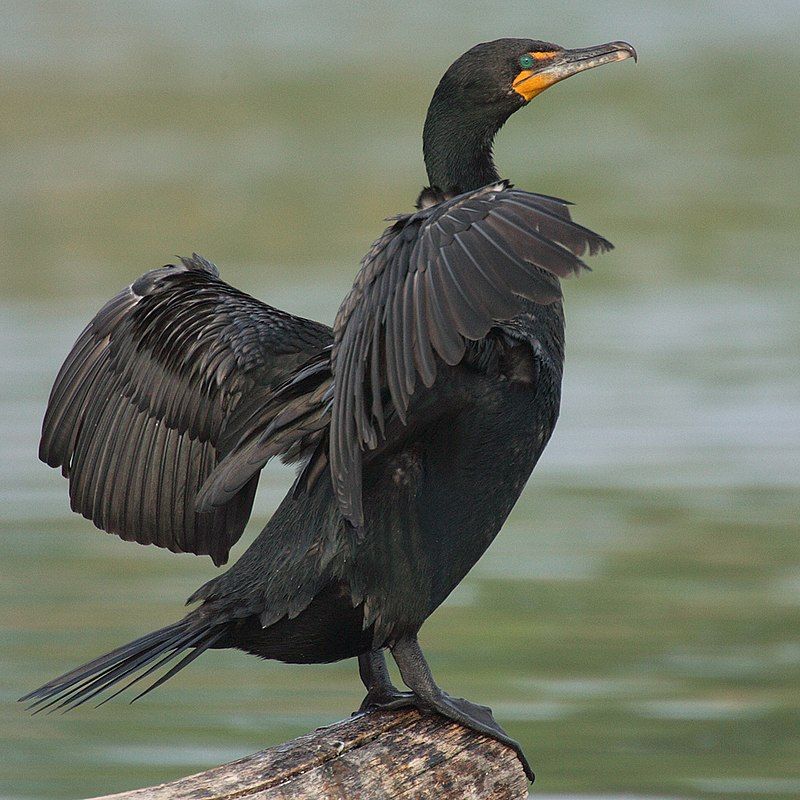
The double-crested cormorant is a type of bird that belongs to the cormorant family. It can be commonly seen near bodies of water such as rivers and lakes. You can also find this bird in coastal areas.
It is not limited to just one region, as it is widely distributed across North America. These birds can be found in various locations throughout North America.
From the Aleutian Islands in Alaska all the way down to Florida and Mexico, they can be seen in different habitats.
This means that they have adapted to survive in a wide range of environments. Being part of the cormorant family, the double-crested cormorant shares certain characteristics with other birds in the same family.
They have long necks and bodies, which are ideal for swimming and diving in water. Their webbed feet help them paddle through the water easily. Due to their ability to swim and dive, the double-crested cormorant can catch fish as their primary food source.
They are excellent underwater hunters, using their sharp beaks to snatch fish from the water. These birds have a unique feature – they have bright blue eyes with two tufts of feathers above them.
| Kingdom | Animalia |
| Phylum | Chordata |
| Clade | Dinosauria |
| Class | Aves |
| Order | Suliformes |
| Family | Phalacrocoracidae |
| Genus | Nannopterum |
| Species | N. auritum |
44. Ruby-Crowned Kinglet
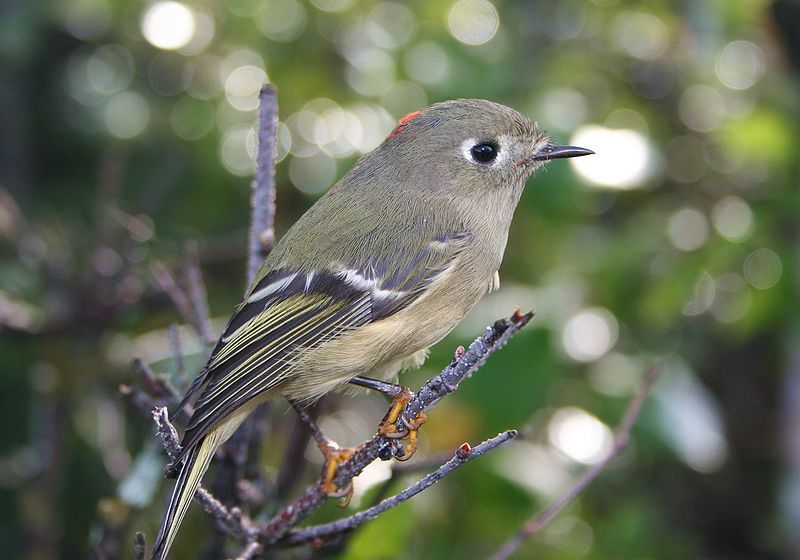
The ruby-crowned kinglet is a small bird that can be found all over North America. It belongs to the kinglet family, which includes other small bird species. This bird has olive-green feathers that cover its body.
Additionally, it has two white bars on its wings and a white ring around its eye. If we look closely, we can notice some differences between males and females of the species. The male ruby-crowned kinglet has a special feature on its head – a red patch on its crown.
However, this patch is not always visible as it is often hidden. On the other hand, female ruby-crowned kinglets do not have this red crown patch. Despite their small size, these birds are known for their energetic and active behaviour.
They are constantly flying and hopping from branch to branch for food. Ruby-crowned kinglets primarily feed on insects, spiders, and small invertebrates found in trees and shrubs. One interesting fact about these birds is that they are known to be quite vocal.
They produce a variety of sounds to communicate with each other. Their songs consist of high-pitched and rapid notes, which can be quite melodic and pleasant to hear. During the breeding season, male ruby-crowned.
| Kingdom | Animalia |
| Phylum | Chordata |
| Clade | Dinosauria |
| Class | Aves |
| Order | Passeriformes |
| Family | Regulidae |
| Genus | Corthylio |
| Species | C. calendula |
45. Saltmarsh Sparrow
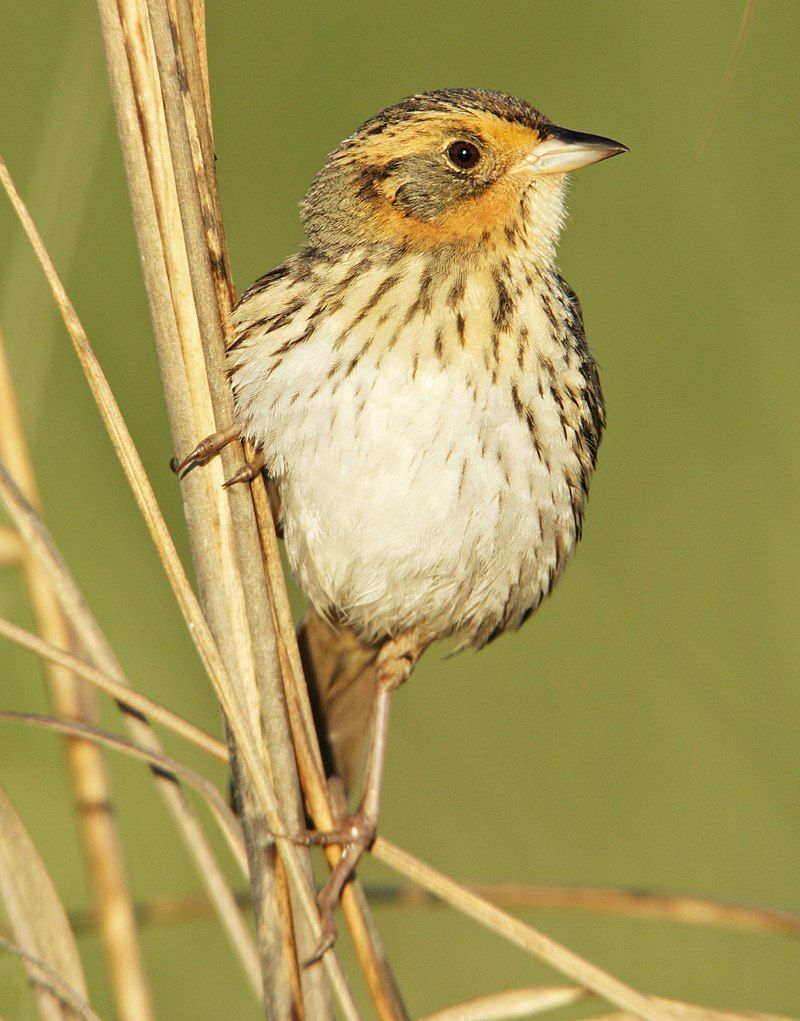
The saltmarsh sparrow is a small bird that can be found in salt marshes along the Atlantic coast of the United States. It is part of the New World sparrow family.
In the past, there was confusion regarding the saltmarsh sparrow and another sparrow called the Nelson’s sparrow.
People used to think that these two birds were actually the same species. Because of this misunderstanding, they were both classified as one species called the sharp-tailed sparrow. Due to this confusion, the saltmarsh sparrow had a temporary name change.
It was known as the “saltmarsh sharp-tailed sparrow” for a short period of time. This change reflected the belief that it was the same species as the Nelson’s sparrow.
However, further research and study revealed that the saltmarsh sparrow and the Nelson’s sparrow are actually distinct species.
They have different characteristics and behaviours that set them apart. As a result, the salt marsh sparrow regained its original name.
It is important to identify and classify different species of birds correctly. This helps scientists and researchers understand their unique traits, habitats, and ecological roles. We can gain valuable insights into the natural world by studying these birds.
| Kingdom | Animalia |
| Phylum | Chordata |
| Clade | Dinosauria |
| Class | Aves |
| Order | Passeriformes |
| Family | Passerellidae |
| Genus | Ammospiza |
| Species | A. caudacuta |
46. LeConte’s Sparrow
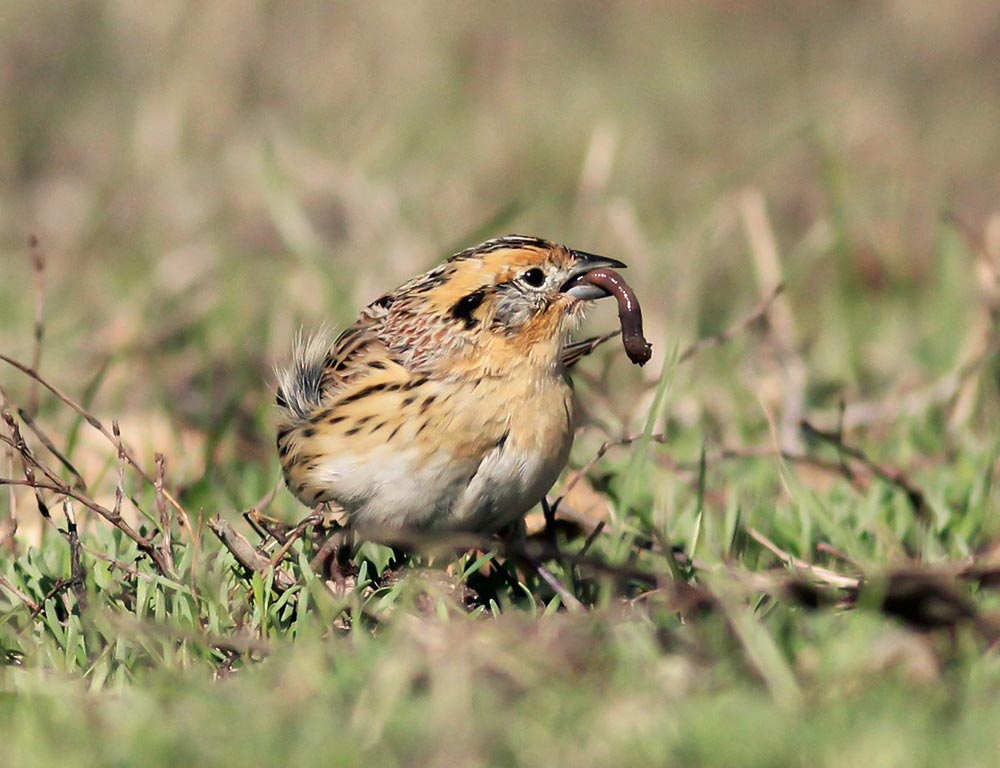
LeConte’s sparrow, also called LeConte’s bunting, is a type of sparrow species found in North America. It is noteworthy for being one of the smallest sparrows in the New World.
This small bird captures the attention of bird enthusiasts and ornithologists due to its unique characteristics and behaviour. LeConte’s sparrow is native to North America’s grasslands and wet meadows.
It is commonly found in the central and northern regions of the continent, particularly during the breeding season.
These sparrows prefer habitats with tall grasses and dense vegetation to seek shelter and ample food sources. One distinguishing feature of LeConte’s sparrow is its petite size. It is notably smaller than other sparrow species found in North America.
This small stature allows it to easily navigate through dense vegetation, making it well-adapted to its preferred habitats. The plumage of LeConte’s sparrow is also remarkable.
It exhibits a combination of subtle colours, typically consisting of various shades of brown, grey, and buff.
This muted colouration serves as camouflage, helping the bird blend in with its grassy surroundings and providing protection from potential predators. Another interesting characteristic.
| Kingdom | Animalia |
| Phylum | Chordata |
| Clade | Dinosauria |
| Class | Aves |
| Order | Passeriformes |
| Family | Passerellidae |
| Genus | Ammospiza |
| Species | A. leconteii |
47. Baird’s Sparrow
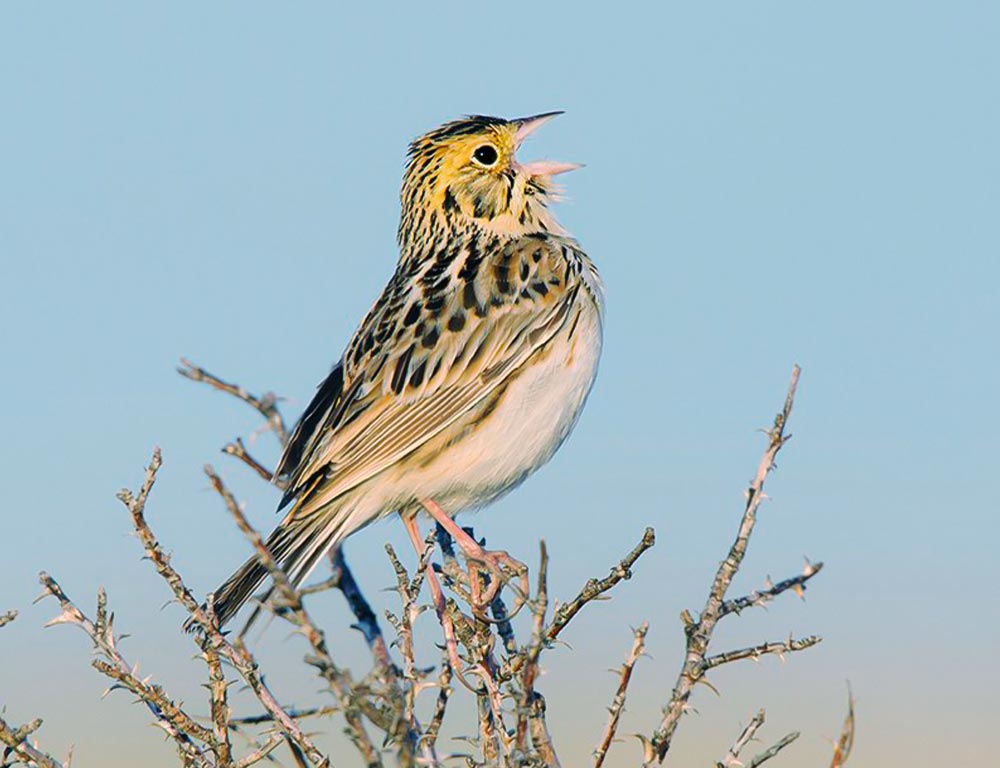
Baird’s sparrow is a type of bird that can be found in North America. Specifically, it belongs to the Passerellidae family, which is a group of birds within the order Passeriformes.
This order includes various other bird species as well. One interesting fact about Baird’s sparrow is that it is migratory. This means that it has a pattern of seasonal movement. These birds travel from one place to another depending on the time of year.
In the case of Baird’s sparrow, its migration takes place within North America. The native range of Baird’s sparrow includes three countries: the United States, Canada, and Mexico. This means that these birds can be found in various regions across these countries.
They have adapted to different habitats within this range, including grasslands, prairies, and shrublands. Baird’s sparrow is known for its unique appearance. It has a small body size, measuring around 12-14 centimetres in length.
The plumage of this bird is mostly brown with streaks and spots. These markings help them blend in with their surroundings, providing camouflage and protection. These sparrows are primarily insectivorous, meaning they mainly feed.
| Kingdom | Animalia |
| Phylum | Chordata |
| Clade | Dinosauria |
| Class | Aves |
| Order | Passeriformes |
| Family | Passerellidae |
| Genus | Centronyx |
| Species | C. bairdii |
Conclusion
Winter birds in North Dakota add a sense of beauty and vibrancy to the otherwise frigid and barren landscape. Despite the harsh conditions, these remarkable creatures survive and even thrive in various ways.
The state is home to a diverse range of winter birds, from large raptors like bald eagles and snowy owls to small songbirds like chickadees and finches.
Their presence brings a sense of wonder and joy to birdwatchers and nature enthusiasts, highlighting the resilience and adaptability of wildlife in cold climates.
It is truly remarkable how these birds navigate through treacherous winters, finding food and shelter and providing a glimpse of hope and life in an otherwise harsh season.
Understanding and appreciating the winter birds in North Dakota can serve as a reminder of the delicate balance of nature and the importance of preserving their habitats for generations to come.